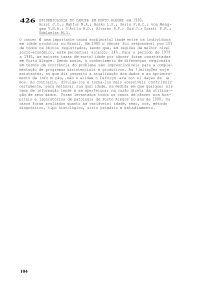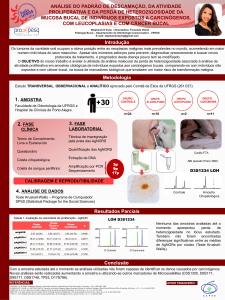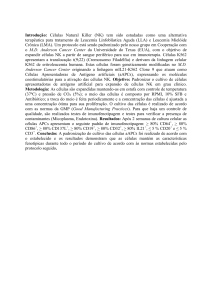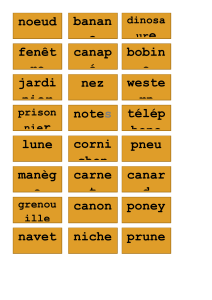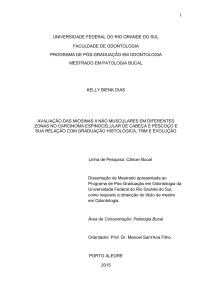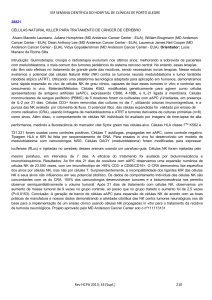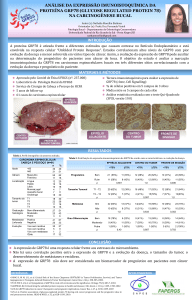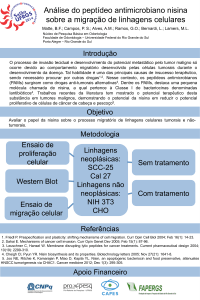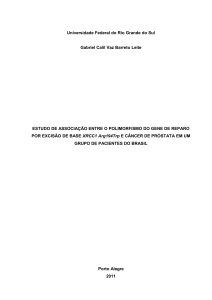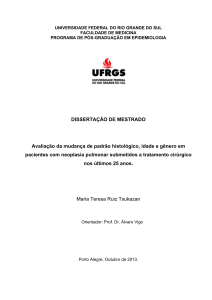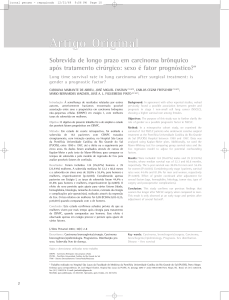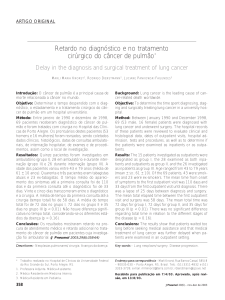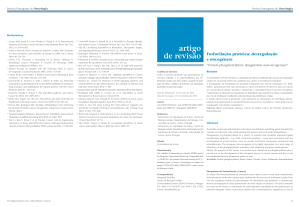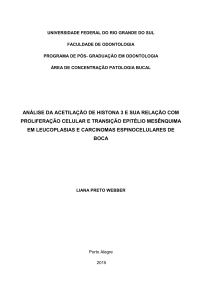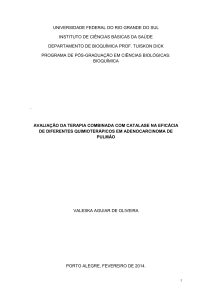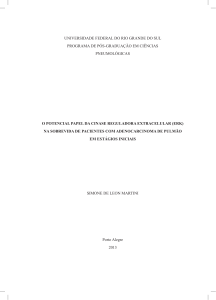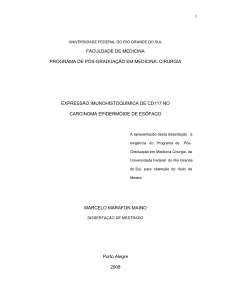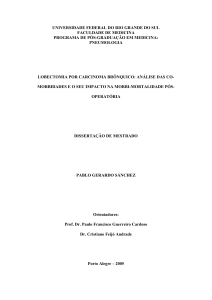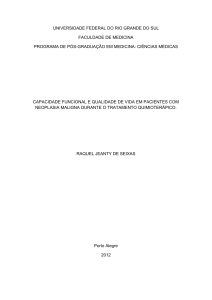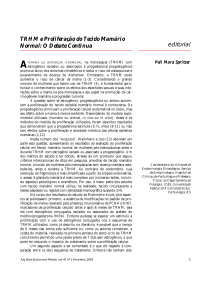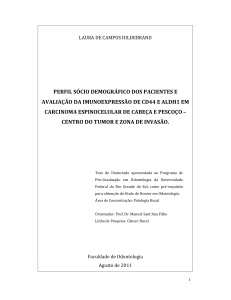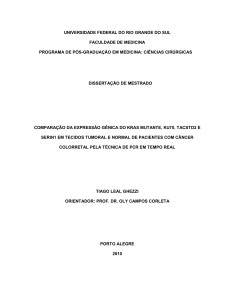UNIVERSIDADE FEDERAL DO RIO GRANDE DO SUL
publicité
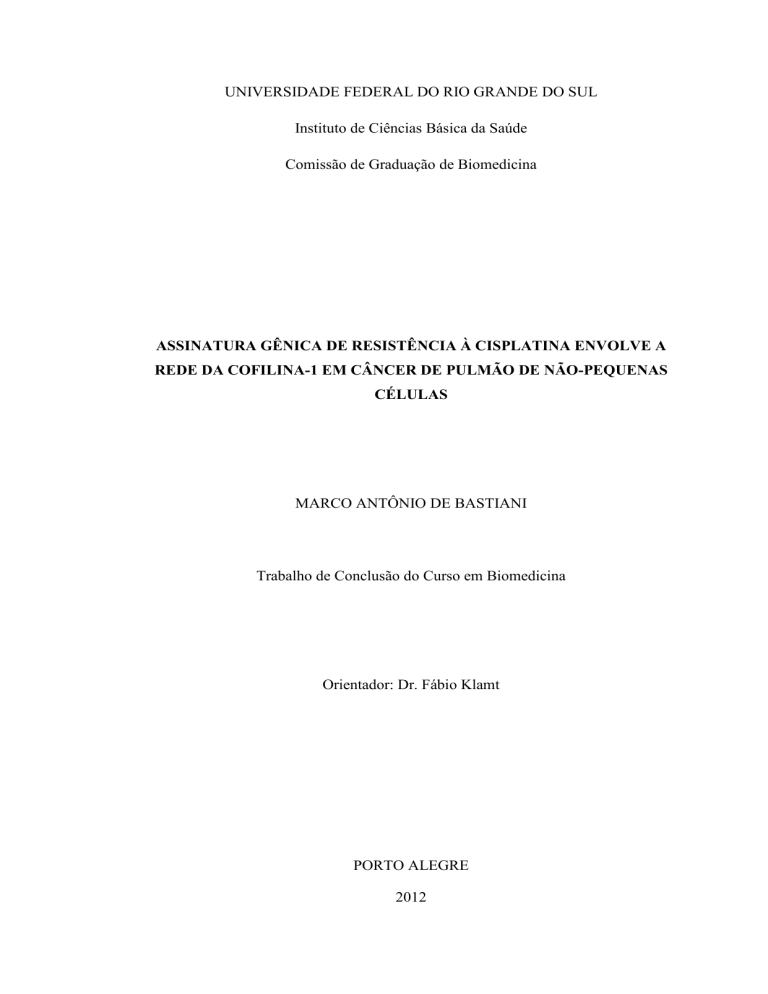
UNIVERSIDADE FEDERAL DO RIO GRANDE DO SUL Instituto de Ciências Básica da Saúde Comissão de Graduação de Biomedicina ASSINATURA GÊNICA DE RESISTÊNCIA À CISPLATINA ENVOLVE A REDE DA COFILINA-1 EM CÂNCER DE PULMÃO DE NÃO-PEQUENAS CÉLULAS MARCO ANTÔNIO DE BASTIANI Trabalho de Conclusão do Curso em Biomedicina Orientador: Dr. Fábio Klamt PORTO ALEGRE 2012 Agradecimentos Agradeço a minha mãe e minhas irmãs pelo apoio e carinho durante esses anos de graduação; por sempre me motivarem em minhas empreitadas e confiarem em mim, quaisquer que sejam minhas decisões; por estarem presentes, apesar da distância e das dificuldades. Também agradeço a meu cunhado Julio Niderauer pela amizade e por ser uma pessoa em quem posso confiar e contar. Agradeço ao pessoal do grupo do professor Fábio – Carolina Muller, Liana Marengo, Ricardo Rocha, Valeska Aguiar e demais – pela amizade e ajuda durante os quatro anos que estou no laboratório e com certeza após a graduação. Em especial, preciso agradecer ao colega Matheus Becker por toda a ajuda e ensinamentos desde que entrou no lab. até o TCC, e certamente por depois da graduação também. Ainda, agradeço as colegas que recentemente deixaram o grupo para seguir outros caminhos – Fernanda Lopes e Giovana Londero – pelas boas lembranças e amizade formada. Também agradeço ao pessoal do laboratório 32 pelas boas lembranças e ao restante do pessoal do laboratório 24 pela disposição e ajuda no dia a dia de trabalho. Agradeço ao professor Fábio Klamt por ter me acolhido em seu grupo de pesquisa; por confiar e investir em meus potenciais e permitir que os desenvolva; por ser alguém em que posso aspirar como profissional e como pessoa; e pela amizade e apoio. Agradeço a todos que de alguma forma contribuíram para minha formação profissional e pessoal nesse tempo único da vida que é a graduação. 2 Índice Resumo .................................................................................................................................... 4 Introdução ........................................................................................................................ 6 I. II. 1. Câncer de Pulmão ........................................................................................................ 6 2. Mecanismo de Ação da Cisplatina ............................................................................... 7 3. Mecanismos de Resistência à Cisplatina...................................................................... 8 3.1 Redução do Acúmulo Intracelular da Droga ........................................................ 8 3.2 Aumento da Inativação Intracelular da Droga por Moléculas Contendo Tióis.... 9 3.3 Aumento da Eficácia dos Mecanismos de Reparo ao DNA............................... 10 3.4 Outros Mecanismos de Resistência Propostos ................................................... 12 3.4.1 Aumento do Importe Nuclear de Proteínas ....................................................... 12 3.4.2 Cofilina-1 ........................................................................................................... 13 Artigo Científico ............................................................................................................ 14 III. Conclusões e Perspectivas .............................................................................................. 48 Referências Bibliográficas ..................................................................................................... 49 Formatação da Revista Molecular Oncology ......................................................................... 52 3 Resumo O câncer de pulmão é a neoplasia maligna mais insidiosa da oncologia, sendo responsável pelo maior número de mortes relacionadas a câncer no mundo. Este câncer pode ser dividido em dois tipos: câncer de pulmão de células pequenas e câncer de pulmão de não-pequenas células (CPNPC). A maioria dos tratamentos de primeira linha atuais baseia-se em agentes alquilantes derivados de platina, como a cisplatina e a carboplatina, utilizados sozinhos ou em conjunto com outras drogas antineoplásicas. A ação antitumoral dos derivados de platina ocorre basicamente em nível de DNA, provocando a formação ligações cruzadas principalmente intra-fitas. Independentemente do regime utilizado, entretanto, é inevitável o surgimento de resistência e, por ser o padrão ouro da terapêutica, a resistência a derivados de platina é um fator importante no desenrolar do tratamento. Três são os principais mecanismos descritos de resistência a esses compostos: aumento do efluxo, da inativação intracelular da droga e aumento da taxa de reparo do DNA. Além disso, outro mecanismo proposto é o aumento da expressão de carreadores da membrana nuclear, que auxiliariam na entrada de proteínas de reparo. Trabalhos anteriores de nosso grupo identificaram a proteína cofilina-1 como um possível biomarcador candidato para CPNPC e esses trabalhos também demonstraram uma possível relação entre os níveis de expressão da proteína cofilina-1 e resistência a agentes alquilantes, onde células que possuem alta expressão (e imunoconteúdo) da proteína possuem uma maior resistência a esses agentes quimioterápicos. Por esse motivo, o objetivo deste trabalho é avaliar a rede de interação gênica da cofilina-1 com relação aos principais mecanismos de resistência descritos pela literatura em um modelo in silico utilizando dados de expressão gênica de microarranjos. Para isso, dados de microarranjo de modelos celulares e biópsias foram extraídos do repositório público Gene Expression Omnibus (GEO) e analisados no software ViaComplex. Esse programa utiliza-se de redes de interação geradas na ferramenta Search Tool for the Retrieval of Interacting Genes/Proteins (STRING) e do dado obtido a partir do microarranjo para avaliar o padrão de expressão de grupos de genes. Além do ViaComplex, também realizamos análises de correlação para investigar a relação de nossos genes de interesse com o processo de resistência à droga. Nossos resultados mostram que o grupo de genes relacionados à cofilina-1 comporta-se similarmente ao grupo de genes relacionados ao reparo por NER na maioria das análises realizadas. Ainda, nossas análises sugerem que o padrão de expressão dos genes das redes varia 4 diferentemente dependendo do agente alquilante e do tipo histológico do tumor. Finalmente, análises dos bancos de dados de biópsias reforçaram dados da literatura que afirmam uma relação entre cofilina-1 e desfecho desfavorável para pacientes em estágios iniciais de CPNPC. 5 I. Introdução 1. Câncer de Pulmão No século XIX, o câncer de pulmão era uma doença rara, representando somente 1% de todos os cânceres vistos em autópsias. Entretanto, já no início do século passado, a incidência de tumores malignos de pulmão aumentou tanto entre homens quanto entre mulheres. Embora a associação entre o cigarro e o câncer de pulmão era suspeitada pelos médicos na década de 1930, a causa do aumento dramático não fora bem estabelecida até estudos epidemiológicos na década de 1950 mostrarem uma forte associação entre o fumo e o câncer de pulmão (Sun et al., 2007). Atualmente, o câncer de pulmão é uma doença insidiosa altamente letal, com o percentual de pacientes que apresentam sobrevida superior a cinco anos variando entre 13 a 21% em países desenvolvidos e entre 7 a 10% em países em desenvolvimento. O principal fator de risco para o seu desenvolvimento é indubitavelmente o tabagismo. Estudos mostram que tabagistas apresentam cerca de 3 a 5 vezes mais risco de desenvolver carcinoma de pulmão quando comparados com pessoas que nunca fumaram, sendo que esse risco diminui significativamente em extabagistas e é proporcional ao quão cedo na vida o indivíduo cessou o hábito (Khan et al., 2010). O tratamento para o CPNPC é determinado pelo estadiamento da doença e classificados de acordo com a descrição TNM dentro de categorias e estágios, sendo que o tipo de estágio da doença envolve uma combinação de fatores que levam em consideração características patológicas do tumor (Mountain, 1997). Por determinar o curso da terapia, esse procedimento é de fundamental importância clínica e está sujeito a revisões e alterações periódicas a fim de aumentar os benefícios para o paciente (Nair et al., 2011). A rescisão cirúrgica continua sendo a principal forma de tratamento para os estágios iniciais e doenças localizadas, contudo a quimioterapia sistêmica também beneficia esses pacientes (Arriagada et al., 2004). Da mesma forma, terapias sistêmicas multimodais tornaram-se uma prática comum para doenças regionalmente avançadas. Embora pacientes com doença avançada e metastática sejam somente candidatos a tratamentos quimioterápicos paliativos, estes apresentam evidências de melhoras na sobrevivência e qualidade de vida dos pacientes (Ramalingam and Belani, 2008). 6 Os benefícios da quimioterapia baseada em agentes alquilantes (com base em platina) como um tratamento de primeira escolha para pacientes com CPNPC avançado foi reportado pela primeira vez no final da década de 80. Mais evidências mostrando a eficácia dessas terapias foram demonstradas subsequentemente por meta-análise de vários ensaios clínicos randomizados. Esta análise demonstrou que a quimioterapia baseada em cisplatina foi associada com uma taxa de sobrevivência de 1 ano (Ramalingam and Belani, 2008). Por esse motivo, agentes alquilantes começaram a ser combinados com outros medicamentos no intuito de melhorar a sobrevida e a qualidade de vida dos pacientes. 2. Mecanismo de Ação da Cisplatina Cisplatina é um complexo inorgânico neutro e planar que reage com o DNA para induzir efeitos biológicos característicos, os quais podem ser de ativação dos mecanismos de reparo do DNA, com consequente sobrevivência celular, ou de ativação irreversível das cascatas apoptóticas. Contudo, a interação com o DNA só ocorrerá após uma série de reações espontâneas da molécula de cisplatina com o meio, que envolvem trocas sequenciais dos ligantes cis-cloro com moléculas de água (Kartalou and Essigmann, 2001; Rabik and Dolan, 2007). A forma resultante é reconhecida como uma espécie altamente apta a reagir com seu alvo de interesse: o DNA. Entretanto, o estado reativo da molécula também pode interagir com muitos nucleófilos endógenos, como glutationa (GSH), metionina, metalotioneína e outras proteínas. A ação citotóxica da cisplatina é descrita pela sua interação com sítios nucleofílicos N7 das purinas no DNA, formando interações proteína-DNA, ligações cruzadas inter- e intra-fitas e monoadutos com o DNA (Rabik and Dolan, 2007), os quais são as principais lesões responsáveis pela morte celular (Siddik, 2003). Mais de 90% dos adutos ciplatina-DNA resultam em ligações cruzadas 1,2 d(GpG) intra-fitas, as quais modificam a estrutura tridimensional da molécula DNA e tornam o local um sítio de reconhecimento para várias proteínas. Estas proteínas de reconhecimento de dano incluem componentes do complexo de reparo MMR (sigla em inglês para mismatch repair) grupo 1 e 2 de proteínas não-histonas de alta mobilidade (HMG1 e HMG2), proteínas relacionadas ao reparo por excisão de nucleotídeos, dentre outras (Rabik and Dolan, 2007; Wang and Lippard, 2005). 7 3. Mecanismos de Resistência à Cisplatina Como já mencionado, cisplatina é o padrão ouro da terapêutica em CPNPC e por esse motivo a resistência a essa droga significa um grande obstáculo para um regime terapêutico eficaz. A quimioresistência pode ser inata ou adquirida e pode referir-se a um único agente ou a uma classe de agentes que compartilhem mecanismos de ação antineoplásicos iguais ou similares. Uma parcela considerável dos pacientes com CPNPC eventualmente desenvolvem resistência contra os quimioterápicos aos quais eles estão expostos, mesmo que tenham apresentado uma resposta inicial boa. Por essa razão, é comum que esses pacientes recebam duas ou três linhas de terapia durante decorrer do tratamento (Chang, 2011). Existem três principais mecanismos de resistência descritos para a cisplatina: redução do acúmulo intracelular da droga, aumento da inativação intracelular da droga e aumento da eficiência do reparo ao DNA. Porém a literatura sugere que alguns outros sistemas também possam estar contribuindo nesse processo. Independentemente do processo, os mecanismos de resistência surgem como consequência de mudanças celulares que podem tanto impedir a droga de interagir com o DNA como interferir com a ativação da resposta aos efeitos citotóxicos, ou ainda ambos os processos. 3.1 Redução do Acúmulo Intracelular da Droga Um primeiro nível de desenvolvimento de resistência é a seleção de mecanismos capazes de impedir ou diminuir o acúmulo intracelular do fármaco. Reduções na ordem de 20-70% foram documentadas em diversas linhagens celulares, e isso mostrou um aumento de resistência à cisplatina em um fator de 3-40 vezes. Entretanto, dada a natureza multifatorial da quimioresistência, a redução na acumulação da droga não parece ser necessariamente diretamente proporcional ao nível de resistência. De fato, o perfil insensibilidade à droga de um dado tipo de linhagem tumoral pode não incluir defeitos na acumulação da droga, ou esse sistema não ser o contribuinte majoritário da resistência. Por outro lado, em alguns cânceres, a redução na acumulação da cisplatina é o principal mecanismo, contabilizando 7090% da totalidade da resistência (Siddik, 2003). 8 A causa da redução na acumulação intracelular da cisplatina nas células resistentes pode ser atribuída por uma inibição na captação da droga, por um aumento no efluxo da droga, ou por ambos. Um defeito no processo de captação, o qual é controlado por transportadores de cobre, parece ser comum e na literatura existe um crescente número de evidências apoiando o papel desses transportadores na resistência tumoral (Howell et al., 2010). O desenvolvimento de resistência como resultado de um aumento no efluxo da cisplatina é outro mecanismo possível de diminuição do acúmulo intracelular da droga. Nesse contexto, estão incluídas várias proteínas transmembrana, em especial proteínas associadas à resistência a múltiplas drogas (MDR, MRP e BCRP) da família de transportadores ABC (do inglês ATP binding cassete). No CPNPC, o grupo de proteínas MRP, composto de pelo menos 7 membros (MRP1-7), foram os principais alvos de investigação. Contudo, somente a MRP2 (cMOAT) parece estar envolvida na resistência à cisplatina, baseado observações de que células resistentes têm níveis elevados deste transportador. Ainda, um aumento de 10X na resistência foi demonstrado em células que superexpressam MRP2 e, além disso, a transfecção de RNA anti-senso contra a MRP2 aumenta a sensibilidade das células à cisplatina. Estudos envolvendo MDR/glicoproteína-p demonstraram-se inconclusivos quanto à resistência à cisplatina, apesar de a superexpressão desse transportador ter sido associada com uma resposta ruim à quimioterapia com essa droga (Siddik, 2003). Observa-se, portanto, que o mecanismo de redução do acúmulo intracelular da droga está fortemente associado com a resistência de diversas linhagens tumorais, não somente contra cisplatina, mas também contra diversos outros fármacos utilizados na clínica. 3.2 Aumento da Inativação Intracelular da Droga por Moléculas Contendo Tióis A cisplatina pode ser inativada por inúmeros constituintes citoplasmáticos, incluindo a abundante molécula nucleofílica glutationa (GSH) e as metalotioneínas ricas em cisteínas. Essas reações de inativação podem ser espontâneas, devido à alta reatividade da molécula de ciplatina após reagir com a água no meio intracelular, ou catalisadas por enzimas, como glutationa S-transferases e sistema de peroxiredoxinas (Pedersen et al., 2009; Tew, 1994). 9 As metalotioneínas são ricas em cisteínas contendo grupos tióis, os quais são centros de interação ideais para a cisplatina. Por essa razão, não é inesperado que aumentos nos níveis celulares de metalotioneínas tenham sido observados em modelos celulares de resistência à ciplatina. Da mesma maneira, concentrações elevadas de moléculas contendo tiol produzem resistência por diminuir os níveis de agente antitumoral disponível para interação com o DNA. O aumento no conteúdo de GSH foi demonstrado em vários modelos tumorais de resistência à cisplatina, e confirmados em estudos clínicos. Elevações na quantidade de GSH intracelular podem ocorrer como resultado de um aumento de expressão do gene de γglutamilcisteíno sintetases (γ-GCS), cujo produto é uma enzima limitante na biossintese de GSH (Siddik, 2003). A reação de conjugação da ciplatina com GSH pode ser catalisada pela glutationa S-transferase π (GSTπ), a qual é membro de uma família de enzimas envolvidas nas reações de detoxificação de xenobióticos. O aumento na expressão de GSTπ, junto com elevados níveis de GSH em células tumorais resistentes, sugerem que a inativação enzimática da cisplatina contribui significativamente para o fenótipo em nível clínico e o aumento nas reações de conjugação entre GSH e cisplatina são geralmente aceitas como um fator significante na resistência (Siddik, 2003). 3.3 Aumento da Eficácia dos Mecanismos de Reparo ao DNA A formação e a persistência dos adutos resultantes da interação entre a molécula de cisplatina ativada com o DNA são vitais na indução do efeito citotóxico da droga, o que culminará na apoptose da célula tumoral. Dessa forma, um aumento na taxa de reparo desses adutos atenuaria o processo apoptótico. A demonstração de que um aumento na taxa de reparo está associado com uma inibição da citotoxicidade induzida pela droga em muitas linhagens de tumores murinos e humanos suporta essa ideia. Como todos os outros mecanismos, o reparo não está universalmente presente em todas as linhagens resistentes à cisplatina. Quando presente, entretanto, a contribuição do aumento no reparo para a resistência é relativamente baixo, e usualmente resulta num acréscimo de resistência na ordem de 1,5-2,0 vezes. Este aumento limitado é, de qualquer forma, considerado como significante uma vez que a inativação dos adutos é em grande parte devido ao reparo do DNA. Esse limite na capacidade de reparo na resistência é apoiado pelo achado de que o aumento do 10 reparo permanece num platô, mesmo quando a resistência à ciplatina aumenta progressivamente em protocolos de exposição crônica à droga (Siddik, 2003; Siddik et al., 1998). O sistema de reparo por excisão de nucleotídeos, ou NER (do inglês nucleotide excision repair), é a principal via para a remoção do dano ao DNA gerado pela ciplatina. A significância desse sistema de reparo é demonstrada pelos achados que defeitos celulares nessa via resultam numa hipersensibilidade à cisplatina, e a restauração desse sistema restabelece a sensibilidade a níveis normais. O sistema NER tem ampla especificidade, e não são observadas diferenças na excisão de adutos induzidos por cisplatina e outras drogas a base de platina. De fato, um aumento no reparo dos adutos nas células resistentes também se aplica a outros análogos de platina, o que sugere que esse mecanismo de resistência talvez seja difícil de ser superado para agentes antineoplásicos baseados em platina (Chaney and Sancar, 1996; Siddik, 2003). Apesar de o sistema NER ser composto de pelo menos 17 diferentes proteínas, parece que upregulation de somente algumas proteínas-chave é necessário para aumentar a capacidade de reparo em células tumorais. Dentre as principais proteínas descritas estão ERCC1 ou o complexo ERCC1/XPF e XPA. Pelo contrário, células de tumor testicular sensíveis à cisplatina expressam níveis muito baixos dessas proteínas (Siddik, 2003). Além do NER, o sistema de reparo de mau pareamento, ou MMR (do inglês mismatch repair) também parece estar envolvido na resistência à ciplatina, pois vários estudos apontam a deficiência nesse mecanismo de reparo como um fator indutor desse processo. Entretanto, esse sistema atua no reconhecimento de dano, apresentando um papel crítico na manutenção da integridade do genoma durante a replicação, e não participa ativamente no reparo de adutos de cisplatina. Uma hipótese proposta é de que o MMR reconhece a lesão causada pela droga e inicia a cascata de indução de apoptose. Dessa forma, se houver um defeito ou perda de eficácia desse sistema, o sinal de apoptose mediado pelo MMR deixa de existir e isso confere a resistência observada (Fink et al., 1998; Martin et al., 2008). Além disso, para manter a estabilidade genômica, é vital que o reparo do DNA ocorra antes da replicação. Contudo, a resistência advém quando as células aumentam sua capacidade de replicar o DNA passando o aduto e, então, iniciando o reparo no período pós-replicação. Isto aumenta a habilidade das células tumorais de tolerar 11 altos níveis de DNA danificado induzido por cisplatina. A este respeito, é significativo que o desvio na replicação é aumentado de 3-6 vezes por defeitos nas proteínas hMLH1 ou hMSH6, as quais apresentam grande importância no papel do MMR na resistência à cisplatina, uma vez elas fazem parte do sistema MMR (Chaney and Sancar, 1996; Martin et al., 2008; Siddik, 2003). 3.4 Outros Mecanismos de Resistência Propostos 3.4.1 Aumento do Importe Nuclear de Proteínas Além dos três mecanismos descritos acima, alguns outros processos descritos na literatura parecem estar relacionados à aquisição de resistência. O primeiro referese ao transporte nuclear aumentado de proteínas envolvidas no reparo ao DNA (Kinoshita et al., 2012). O transporte de proteínas do citoplasma para o núcleo e viceversa ocorre através do complexo de poro nuclear (NPC, do inglês nuclear pore complex), o qual é formado por cerca de 30 nucleoporinas, algumas das quais possuem sítios de ligação com carioporinas, ou importinas. Importinas formam uma superfamília de proteínas que reconhecem sequências de localização nuclear (NLS, do inglês, nuclear localization signal), geralmente grupos de resíduos de aminoácidos ácidos, e então medeiam o trânsito para o núcleo. O complexo importina α/β é um complexo chave na via de importe nuclear em eucariotos e esse mecanismo é usualmente referido como importe nuclear clássico. Uma segunda via de transporte nuclear ocorre quando proteínas que não possuem NLS formam complexos com outra que o possui e, dessa maneira, podem ser importadas. Ainda não está claro se esse mecanismo de co-importe é um sistema de reserva ou se ele é essencial para a regulação do importe nuclear in vivo. De qualquer maneira, até agora, o importe via co-importe só foi observado para proteínas que funcionam em complexos bem definidos durante o reparo por excisão. Finalmente, outras rotas de transporte, referidas como mecanismos de transporte alternativos e os quais independem de importinas, também já foi identificado. Dados sugerem que proteínas que utilizam a rota alternativa possam ligar-se diretamente com nucleoporinas e serem transportadas (Knudsen et al., 2009; Sorokin et al., 2007). 12 3.4.2 Cofilina-1 Outros trabalhos na literatura propõem o envolvimento da proteína cofilina-1 na resistência à cisplatina (Castro et al., 2010). A família de proteínas ADF/cofilina é expressa em todas as células eucarióticas e em três formas nos mamíferos: ADF (actin-depolymerizing factor), cofilina-1 (a principal forma nos tecidos nãomusculares) e cofilina-2 (a principal forma no músculo). A cofilina-1 é uma proteína ubíqua de aproximadamente 19 kDa que é capaz de ligar-se tanto a actina-G (monomérica) quanto a actina-F (filamentosa), sendo um reconhecido fator de regulação dinâmica de polimerização e despolimerização dos filamentos de actina (Wang et al., 2007). Além das suas propriedades reguladoras da dinâmica de citoesqueleto, a cofilina-1 apresenta outras funções celulares. Uma delas é a capacidade de translocar para o núcleo após alguns estímulos químicos ou físicos. Essa translocação nuclear somente ocorre se a proteína estiver no seu estado ativado, ou seja, defosforilado, uma vez que somente nesse estado a cofilina-1 expõe a sua sequência de sinalização nuclear. Ainda, estudos mostraram que a cofilina-1 apresenta a função de carrear actina consigo para o núcleo (Pendleton et al., 2003). Por outro lado, estudos de proteômica mostraram que a cofilina-1 foi encontrada translocando para a mitocôndria após indução de apoptose por estaurosporina em células de neuroblastoma e, em linfomas, a oxidação da cofilina-1 também promove sua translocação para a mitocôndria e morte celular programada (Chua et al., 2003; Klamt et al., 2009). Portanto, a resistência aos agentes alquilantes pode surgir de diversas associações e rotas intracelulares. O que é notável é que uma única via dificilmente será a exclusiva responsável por esse fenômeno e, por essa razão, o estudo de uma única rota intracelular parece ser insuficiente para se chegar a uma conclusão sobre os mecanismos de resistência desenvolvidos pelas células tumorais a estes fármacos. 13 II. Artigo Científico Cisplatin resistance signature in non-small cells lung cancer involves the CFL1associated gene network Marco A. De Bastiani1, Matheus Becker1, Mauro Antônio A. Castro1, Fábio Klamt1 Authors’ Affiliation: 1 Laboratory 24, Department of Biochemistry, ICBS/UFRGS, Porto Alegre/RS, Brazil, Ramiro Barcelos 2600 - Anexo, Rio Branco. Corresponding Author: Marco A. De Bastiani; Phone – 555184523814 / 555132375021; E-mail – [email protected]; Laboratory 24, Department of Biochemistry, ICBS/UFRGS, Porto Alegre/RS, Brazil, Rua Ramiro Barcelos 2600 Anexo, Rio Branco. Abstract Lung cancer is one of major causes of cancer-related deaths in the world and non-small cell lung cancer is the most frequently diagnosed type of lung cancer. The main clinical interventions are therapies based on alkylating agents such as cisplatin. Therefore, resistance to cisplatin poses as a major obstacle in the treatment of these patients. Early studies showed that the CFL1 gene product cofilin-1 might be associated with cisplatin resistance in non-small cells lung cancer. In this study we employ a bioinformatic approach based on microarray data analysis to investigate this hypothesis, and for that, five microarray datasets (three tumor cell lines datasets – two containing different cell line panels and one including an acute treatment with cisplatin – and two tissue biopsies datasets – one comprising tumor versus control samples and one deriving from early stages non-small cell lung cancer patients) were utilized. We observed that the CFL1-associated genes behaved similarly to the major mechanisms of cisplatin resistance cited in literature and that it also responded to cisplatin treatment together with these mechanisms in cell lines models. Likewise, tissue biopsies demonstrated elevated CFL1-associated genes in tumor cells, as well as the other mechanisms compared. In especial, our results showed a tight correlation between CFL1-associated gene activity and excision repair mechanism of resistance both in cellular models and tissue microarray data. Altogether, our findings suggest that the CFL1-associated network might play a role in cisplatin resistance as well as in the non-small cells lung cancer development and treatment. 14 Keywords: Non-small cells lung cancer, cisplatin resistance, cofilin, microarray. Highlights CFL1-associated network follows similar pattern of gene activation as NER network in alkylating agents resistant cell lines and after acute treatment of NSCLC cell line with cisplatin, which suggests that its role in chemoresistance might be by contribution to NER pathway. Correlation analysis suggests that CFL1-associated network presents differential contribution to drug resistance depending on histological type and alkylating agent utilized. Increased CFL1-associated network gene activation in patients with low overall survival in stage I of NSCLC supports the use of this network in predictive evaluation of recently diagnosed NSCLC patients. 1. INTRODUCTION Lung cancer is one of the most insidious malignant tumors in oncology, ranking among the top causes of cancer-related deaths and showing high prevalence in both sexes (Jemal et al., 2011). Approximately 80-85% of all lung cancers are non-small cell lung cancer (NSCLC), which include squamous cell carcinoma, adenocarcinoma, and large-cell carcinoma. For these patients, chemotherapy forms the foundation of their treatment and is critical in determining their survival and quality of life. Currently, the platinum-based therapy with ciplatin, carboplatin or oxaliplatin is the mainstay of chemotherapy for NSCLC and is usually given in combination with other agents (Ramalingam and Belani, 2008). Unfortunately, despite these therapies, the disease is rarely curable and prognosis is poor, with overall 5-year survival rate of only 15%. Several factors contribute to such low survival rate and one of the most common includes tumor cell resistance (chemoresistance) to cisplatin. Chemoresistance may be innate or acquired and may apply to a single agent or to a class of agents with same or similar antineoplasic mechanisms of action (Chang, 2011; Siddik, 2003; Torigoe et al., 2005). The literature describes three major mechanisms of resistance to cisplatin. The first includes increased efflux, associated with membrane proteins, notably multidrug resistance (MDR) and multidrug 15 resistance protein (MRP), of the ATP binding cassette (ABC) transporter family encoding efflux pumps, and copper-transporting ATPases (Dmitriev, 2011; Kuo, 2009; Parker et al., 1991). The second mechanism includes intracellular drug inactivation via metallothioneins (Pedersen et al., 2009) and glutathione-related enzymes systems (Laborde, 2010; Tew, 1994). Cisplatin exerts its cytotoxic effect by disrupting the DNA macromolecule, mainly through the formation of intra-strand adducts and inter-strand crosslinks that are repaired through the nucleotide excision repair (NER) pathway (Wang and Lippard, 2005). Therefore, the third well established mechanism of chemoresistance to cisplatin is enhanced repair system machinery. It is also postulated that tumors that are defective in mismatch repair (MMR) pathway also become more resistant to cisplatin than their MMR-proficient counterparts (Rosell et al., 2002). Moreover, since these repair pathways take place in the nucleus, all proteins necessary for these repair activities must be translocated to this compartment. For that reason, nuclear translocation presents a supplementary mechanism for regulation of DNA repair activity (Knudsen et al., 2009) and play an important role in the chemoresistance (Kinoshita et al., 2012). In addition, deregulation of nuclear transport is implicated in the mislocalization and altered function of a variety of proteins, including tumor suppressors, which can have dire cellular consequences and potentially lead to the initiation and progression of cancer (Fabbro and Henderson, 2003). Although each of the mechanisms mentioned may play an important role in the chemoresistance to cisplatin, it is important to realize the multifactorial nature of the drug resistance. In other words, it is possible that one tumor cell utilizes a combination of two of those mechanisms or even the three of them, even if the majority of the resistance effects are distributed unequally among these systems. Therefore, when studying chemoresistance, it is important to evaluate the status and the contribution of all the mechanisms. This approach is essential to identify which process is responsible for the final effect or even to search for possible new players that may be leading or contributing to the development of the drug resistance phenotype. However, to deal with the high complexity of biological processes, bioinformatic tools and high-throughput methodologies, such as microarray, have become important experimental approaches (Lonning et al., 2007). Previous studies of our group analyzed the relation between drug toxicity of 118 chemotherapy agents withthe gene expression patternsof six NSCLC cell lines of 16 the NCI-60 human tumor cell line anticancer drug screen reported the possible involvement of cofilin-1 in the resistance to alkylating agents (Castro et al., 2010). Cofilin-1 is the product of CFL1 gene and a member of the ADF/cofilin family of proteins, classically involved in the regulation of the actin cytoskeleton dynamic. In recent years, however, several other functions have been attributed to cofilin-1, such as its nuclear translocation under cellular stress, nuclear translocation of actin and induction of apoptosis via mitochondrial translocation (Chua et al., 2003; Klamt et al., 2009; Pendleton et al., 2003). In this study, we aim to explore the role of cofilin-1 in the chemoresistance to cisplatin by analyzing the CFL1-associated gene network expression together with the gene network of other mechanisms of resistance in five microarray datasets of NSCLC extracted from the Gene Expression Omnibus public repository. 2. MATERIALS AND METHODS 2.1 Microarray Datasets The microarray data was extracted from the Gene Expression Omnibus (GEO) repository (http://www.ncbi.nlm.nih.gov/geo/) utilizing the key words “cisplatin” or “alkylating agents” and “non-small cell lung cancer”. Three datasets of interest were chosen and analyzed: GEO ID: GSE4127; GSE6410; GSE11117; and GSE14814. In addition, we utilized the NCI-60 cancer cell panel (GEO ID: GSE5846). When available, the datasets were downloaded as raw data and normalized using the Affymetrix® Expression Console™ software (v.1.1). 2.2 Construction of the Networks The genes for NER and MMR networks were extracted from the pathways database of the Kyoto Encyclopedia of Genes and Genomes (http://www.genome.jp/kegg/pathway.html) in Kegg map: hsa03420; and Kegg map: hsa03430, respectively. The genes selected for the Inactivation/Efflux and Nuclei Import networks were curated from the literature (Dmitriev, 2011; Gelain et al., 2009; Knudsen et al., 2009; Siddik, 2003; Teng et al., 2006). The CFL1 interaction network was extracted from Castro et al (Castro et al., 2010). After the gene selection, the network was built utilizing the Search Tool for the Retrieval of Interacting Genes/Proteins (STRING) version 9.0 (http://string17 db.org/). All genes collected served as entry for the database and filtered for “experiments”, “medium confidence”, plus one layer of interaction. Genes that did not form interactions were excluded and each mechanism was grouped manually using the Medusa interface. The genes added by the second layer of interaction were grouped and termed “Linkers”, for they helped unite the network. The resultant network is presented in figure 1. 2.3 Gene Expression Network Analysis and Statistics For the gene expression analysis we utilized the ViaComplex software version 1.0 (Castro et al., 2009). The main advantage of this program is that it is able to distribute a given quantity (quantitative or qualitative data) onto gene/protein interaction networks. To do this, ViaComplex overlaps functional information (e.g. microarray data) with interaction information (supplied by the gene network built). We utilized statistical analysis available in the ViaComplex software which estimates the relative expression level of Groups of Functionally Associated Genes (GFAGs) and is describe elsewhere (Castro et al., 2007). Briefly, to obtain a quantitative parameter that characterizes the functional state of each Group of Functionally Associated Genes (GFAG) in the sample, ViaComplex measures the information content using Shannon’s entropy. We display the data of activity derived from the comparisons. Unless otherwise mentioned, the analyses of diversity of the comparisons were non-significant. Some additional analyses of correlation were made using Pearson correlation statistics. 50% growth inhibition values of cisplatin and carboplatin were obtained in the Mechanism of Action drug activity database of the National Cancer Institute Developmental Therapeutics Program (http://discover.nci.nih.gov/datasetsNature2000.jsp) and http://www.biomedcentral.com/content/supplementary/1471-2407-6-174-S1.doc provided by Gemma et al (Gemma et al., 2006). 3. RESULTS 3.1 Tumor cell lines datasets In a recent study, Castro et al. analyzed the correlation between gene expression and drug toxicity (GI50 values) of six NSCLC cell lines extracted from 18 the NCI-60 panel and observed that high levels of CFL1 mRNA were correlated with resistance against different anticancer drugs—mainly alkylating agents (Castro et al., 2010). Here we evaluated our resistance network utilizing the GSE4127 dataset, which contains gene expression of 29 lung cancer cell lines (10 NSCLC adenocarcinomas, 9 NSCLC squamous cells carcinomas and 10 small cells). The authors also provide the GI50 values of cisplatin in each cell line (Gemma et al., 2006). In figure 2A, we utilized the ViaComplex software to investigate the gene expression relation between the cell line with higher GI50 versus the cell line with lower GI50 values. There was significant increase in the expression of the CFL1 cluster, as well as in the NER, inactivation/efflux and linkers clusters. However, we observed no correlation when the cell lines where grouped according to histological type and then analyzed (data not shown). We also investigated the role of each gene of our network by analyzing the Pearson correlation between gene expression and cisplatin GI50 for all 99 genes. For that, we analyzed the NCI-60 tumor cell line panel and altogether the two datasets comprised 25 NSCLC cell lines (15 adenocarcinomas and 10 squamous cells carcinomas). 17 genes showed significant Pearson correlation when all cell lines were analyzed. When grouped by histological type, we found significant correlation for 13 genes for adenocarcinomas and 8 genes for squamous cells carcinomas (see appendix A for complete data). The cisplatin derivate carboplatin is also an important antineoplasic agent frequently utilized in clinic due to its milder side effects. Carboplatin share similar mechanism of action with cisplatin, and cross-resistance between these two drugs is a well observed phenomena. Hence, to strengthen the relevance of the data obtained for cisplatin, we performed the Pearson correlations of gene expression of our network versus carboplatin GI50. As expected, most of the genes that showed correlation in the cisplatin analysis also showed correlation for carboplatin (see appendix B for complete data). Surprisingly, the number of genes exhibiting significant correlation in the carboplatin analysis was higher than in the cisplatin analysis. This might suggest that, although both agents share common resistance mechanisms, the groups of genes analyzed appear to play different contributions to the level of resistance against each drug. When the cell lines were grouped by histological type, the results displayed similar pattern, which implies that histological type also accounts for different resistance outcome. Nevertheless, some genes appear 19 to play special roles in this context, as they were commonly observed for both drugs and both histological types (see appendix C for details). These data are summarized in Figure 2B. So far, our results showed that the most resistant cell lines to ciplatin display enhanced gene expression of the CFL1 associated group and mostly NER group. If these processes are important to the intrinsic or acquired resistance, it is reasonable to think that ciplatin insult will promote increase in gene expression of these groups. To test this assumption, we utilized the GEO dataset GSE6410, in which gene expression changes in response to acute cisplatin treatment were analyzed by microarray technology in A549 NSCLC cells. Cells were treated with 50 µM of cisplatin (or drug-free media) for 1 hour and incubated for a further 10 hours in drugfree media before the cisplatin-induced gene expression changes were investigated. Control and cisplatin-treated samples were collected from three independent experiments (Almeida et al., 2008). Once again, the CFL1 associated genes showed significant increase in expression, along with NER cluster (figure 3). Changes in gene expression of linkers, Nuclei Import and inactivation/efflux gene groups did not reach statistical significance. 3.2 Tumor biopsies datasets We next aimed to evaluate a possible clinical relevance for the CFL1 associated gene network. To our knowledge, there is no GEO dataset with microarray data of biopsies of NSCLC patients resistant to cisplatin or alkylating agents. Hence, we utilized the GSE11117 and GSE14814 datasets to analyze our network. In GSE11117 dataset, tissue samples from a series of 41 chemotherapynaïve non-small cell lung cancer patients and 15 control patients with inflammatory lung diseases were obtained during routine clinical procedures and gene expression profiles were obtained using a highly sensitive oligonucleotide array platform (Baty et al., 2010). For our analysis, we utilized only patients with adenocarcinoma or squamous cells carcinoma compared to the control samples provided. For both histological types, tissue microarray data showed increased activity of CFL1 associated genes and NER cluster (figure 4). For the comparison of adenocarcinoma versus control, the inactivation/efflux group also displayed increased expression (figure 4A), and for the squamous cells carcinoma versus control comparison, the linkers group exhibited significant statistical increase (figure 4B). However, the 20 increase observed in the linkers cluster did not appear to be homogeneous throughout the group (data not shown). Recent clinical trials have led to the adoption of adjuvant cisplatin-based chemotherapy for patients with resected stages IB to IIIA NSCLC. The 5-year survival advantage conferred by this approach in these studies ranged from 4% in the International Adjuvant Lung Trial to 15% in National Cancer Institute of Canada Clinical Trials Group JBR.10 (Pisters et al., 2007; Winton et al., 2005). Therefore, we next aimed to investigate the role of CFL1 associated genes in early stages of NSCLC utilizing the GSE14814 dataset, which provides gene expression profiling of mRNA isolated from frozen JBR.10 tumor samples (Zhu et al., 2010). We first divided the patients by histological type then analyzed those with adenocarcinoma and squamous cells carcinoma by Pearson correlation of overall survival (OS) versus expression of each gene of our network (see appendix D and E for detailed data). Our results show a different pattern of correlation between the two histological types, with adenocarcinoma displaying greater response of CFL1 network in both stages I and II. In the International Adjuvant Lung Trial and the National Cancer Institute of Canada Clinical Trials Group JBR.10, the application of cisplatin-based chemotherapy has been controversial for patients in stage I, as neither showed a significant survival benefit in stage IB and a potential detrimental effect was observed in stage IA. Thus, we examined a possible involvement of CFL1 associated genes with these outcomes. For this, we grouped the adenocarcinoma and squamous cells carcinoma patients in lower-50 and upper-50 values of OS, and then, utilizing the ViaComplex statistical analysis, we compared lower-50 patients versus upper-50 patients. As presented in table 1, the results showed that for both histological types, the lower-50 patients, those presenting poorer outcome, displayed increased activity of the CFL1-associated genes. In addition, the adenocarcinoma group also showed increased activity of the inactivation/efflux cluster. 4. Discussion The use of tumor cell lines has become a powerful tool of investigation in oncology, increasing our understanding of several molecular mechanisms and pathways in cancer (Gazdar et al., 2010; van Staveren et al., 2009; VoskoglouNomikos et al., 2003). To explore the potential role of CFL1-associated network in 21 the cellular resistance to cisplatin, we first investigated the differences in gene expression of cisplatin resistant lung cancer cell line in comparison to drug sensible cell line. The results showed increased expression of NER and inactivation/efflux clusters, two well described processes involved in chemoresistance. Similarly, the CFL1-associated network also displayed increased gene activity, which might suggest its involvement in resistances mechanisms. The lack of significance in MMR and nuclei import gene groups is not surprising, as it is expected that cells do not necessarily display all mechanisms at the same time (Perez, 1998). When acute response to cisplatin treatment was investigated utilizing a dataset of treated and untreated NSCLC cell line, CFL1-associated genes again showed enhanced activity together with NER related gene. These results might imply that CFL1-associated network could be somewhat contributing with NER system. The translocation of cofilin-1 with actin to the nucleus has been described by Pendleton and colls as a requirement for certain stress-induced responses; however other possible roles of cofilin-1 in the nuclear context might be possible (Pendleton et al., 2003). We also evaluated the possible role of each gene in the resistance context of NSCLC by investigating the Pearson correlation between cisplatin or carboplatin GI50 versus gene expression in adenocarcinomas and squamous cells carcinomas. The different set of gene expression related with the increasing resistance to these drugs suggests that, although sharing the same resistance group, distinct genes might be playing special roles in the resistance to one drug and not to the other. For instance, the gene MAP3K5 – a member of MAP kinases family associated with cascades of cellular responses evoked by changes in the environment and mediating cell survival, differentiation and apoptosis – appears correlated with carboplatin drug response and not cisplatin; the same happens to some members of ERCC family and RAD23A, involved in NER function. Furthermore, disparities in histological type should be taken into account when analyzing chemoresistance, as the faction of genes regulated also varies. When observe the genes that show correlation for both drugs, but consider the histological type, we see several members of the GTF2H family of transcription factors, ERCC3, TPI, and others, displaying correlation in adenocarcinomas but not in squamous cells carcinomas. Nevertheless, our results show that some genes might play key roles in this context, as they appeared to be common to both alkylating agents and histological type. Unsurprisingly, such general genes are included in NER, MMR and inactivation/efflux mechanisms. Contrarily, 22 CFL1-associated genes seem to follow a somewhat histological and/or agent-specific involvement in the chemoresistance context. Although cell line models are a recognized instrument in molecular oncology studies, the fact that they fail to express the totality of the tumor microenvironment is a major bias that should be taken into account (van Staveren et al., 2009). For that reason, we also investigated the clinical importance of CFL1-associated genes utilizing NSCLC biopsies datasets. When NSCLC patients with adenocarcinoma or squamous cells carcinoma were compared to control patients, once again we observed increased gene activity of NER group together with CFL1-associated cluster. In accordance with the cell line models, CFL1 network seems to be activated together with NER cluster in the tumor tissue when compared to control tissue. In addition, we again found the differential histological context influencing the processes active in our network, as observed by the increased expression of the inactivation/efflux group in adenocarcinoma, but not in squamous cells carcinoma. It is important to point out at this point that the control group provided was patients with inflammatory lung diseases. The inflammatory context of the tumor is a well recognized modulatory factor to the tumoral development and the attenuation of this variable here might bias the real circumstance regulating our network as a whole (Coussens and Werb, 2002; Demaria et al., 2010). Nonetheless, the consistency of our findings and the place of this dataset in the midground between the total lack of tumoral context observed in cell lines models and the full complexity displayed in vivo support the possible involvement of CFL1 network in tumor development. Recent clinical trials have re-confirmed the efficacy of alkylating agentsbased chemotherapies in early stages NSCLC patients, especially for adjuvant cisplatin-based combinations. However, for stage I patients, the adoption of these treatments did not show significant overall survival alterations, but a potential detrimental effect was observed (Muller et al., 2011; Pisters et al., 2007; Winton et al., 2005). Thus, we aimed to investigate the role of CFL1-associated network in early stages of NSCLC. Following the pattern of histological influence observed so far in our results, we analyzed the Pearson correlation between overall survival versus gene expression of stage I and II patients with adenocarcinoma and squamous cells carcinoma separately. Difference in gene activation pattern also varied according to histological type in both stages. However, conversely to the cell line model, tumor biopsies showed greater response of our network for the 23 adenocarcinoma group, not for squamous cells carcinomas, in both stage I and II. This discrepancy might be a reflection of a tumor context absent in cellular models. Finally, when we divided stage I patients with NSCLC in lower-50 and upper-50 according to overall survival rate and compared their gene expression, we observed that for both histological types the CFL1-associated cluster showed increased activity. This result suggests that these genes may be somewhat associated with lower survival. Indeed, in a recent study, Muller et al. reported that early stage NSCLC patients presenting higher expression of cofilin-1 displayed poorer clinical outcome (Muller et al., 2011). Although we did not find correlation significance for the CFL1 gene, our data support a possible involvement of its network in this scenario. Moreover, the enhance activity of CFL1-associated group in stage I patients and the debate over the possible inefficiency of cisplatin-based therapies for these patients could mean that these genes are playing some role in the resistance to cisplatin. Additionally, according to our results, this effect might be specially accentuated in patients with adenocarcinoma. In this case, the use of alkylating agents-based therapies should be re-evaluated as a first line intervention for these patients. Therefore, further studies are necessary to fully understand the involvement of cofilin-1 and its associating partners in the development of NSCLC resistance to cisplatin and also the possible clinical application of this in prognostic and treatment. 5. Conclusion In summary, our results point out a possible involvement of CFL1-associated genes in cisplatin resistance in non-small cell lung cancer. We also observed that the increased activity of these genes occurred together with enhanced activity of NERrelated network, suggesting that the CFL1 group contribution to chemoresistance may be happening via NER pathway. Additionally, cell line models showed that the participation of CFL1 network was different according to histological type, fact that was further supported by biopsies microarrays. Finally, tissue datasets also demonstrated that increased in CFL1-associated genes could be involved in lower survival and in alkylating agents chemotherapy inefficacy of NSCLC patients. 24 REFERENCES Almeida, G.M., Duarte, T.L., Farmer, P.B., Steward, W.P., Jones, G.D., 2008. Multiple end-point analysis reveals cisplatin damage tolerance to be a chemoresistance mechanism in a NSCLC model: implications for predictive testing. International journal of cancer. Journal international du cancer 122, 1810-1819. Baty, F., Facompre, M., Kaiser, S., Schumacher, M., Pless, M., Bubendorf, L., Savic, S., Marrer, E., Budach, W., Buess, M., Kehren, J., Tamm, M., Brutsche, M.H., 2010. Gene profiling of clinical routine biopsies and prediction of survival in non-small cell lung cancer. American journal of respiratory and critical care medicine 181, 181188. Castro, M.A., Dal-Pizzol, F., Zdanov, S., Soares, M., Muller, C.B., Lopes, F.M., Zanotto-Filho, A., da Cruz Fernandes, M., Moreira, J.C., Shacter, E., Klamt, F., 2010. CFL1 expression levels as a prognostic and drug resistance marker in nonsmall cell lung cancer. Cancer 116, 3645-3655. Castro, M.A., Filho, J.L., Dalmolin, R.J., Sinigaglia, M., Moreira, J.C., Mombach, J.C., de Almeida, R.M., 2009. ViaComplex: software for landscape analysis of gene expression networks in genomic context. Bioinformatics 25, 1468-1469. Castro, M.A., Mombach, J.C., de Almeida, R.M., Moreira, J.C., 2007. Impaired expression of NER gene network in sporadic solid tumors. Nucleic acids research 35, 1859-1867. Chang, A., 2011. Chemotherapy, chemoresistance and the changing treatment landscape for NSCLC. Lung Cancer 71, 3-10. Chua, B.T., Volbracht, C., Tan, K.O., Li, R., Yu, V.C., Li, P., 2003. Mitochondrial translocation of cofilin is an early step in apoptosis induction. Nature cell biology 5, 1083-1089. Coussens, L.M., Werb, Z., 2002. Inflammation and cancer. Nature 420, 860-867. Demaria, S., Pikarsky, E., Karin, M., Coussens, L.M., Chen, Y.C., El-Omar, E.M., Trinchieri, G., Dubinett, S.M., Mao, J.T., Szabo, E., Krieg, A., Weiner, G.J., Fox, B.A., Coukos, G., Wang, E., Abraham, R.T., Carbone, M., Lotze, M.T., 2010. Cancer and inflammation: promise for biologic therapy. J Immunother 33, 335-351. Dmitriev, O.Y., 2011. Mechanism of tumor resistance to cisplatin mediated by the copper transporter ATP7B. Biochemistry and cell biology = Biochimie et biologie cellulaire 89, 138-147. 25 Fabbro, M., Henderson, B.R., 2003. Regulation of tumor suppressors by nuclearcytoplasmic shuttling. Experimental cell research 282, 59-69. Gazdar, A.F., Gao, B., Minna, J.D., 2010. Lung cancer cell lines: Useless artifacts or invaluable tools for medical science? Lung Cancer 68, 309-318. Gemma, A., Li, C., Sugiyama, Y., Matsuda, K., Seike, Y., Kosaihira, S., Minegishi, Y., Noro, R., Nara, M., Seike, M., Yoshimura, A., Shionoya, A., Kawakami, A., Ogawa, N., Uesaka, H., Kudoh, S., 2006. Anticancer drug clustering in lung cancer based on gene expression profiles and sensitivity database. BMC cancer 6, 174. Jemal, A., Bray, F., Center, M.M., Ferlay, J., Ward, E., Forman, D., 2011. Global cancer statistics. CA: a cancer journal for clinicians 61, 69-90. Kinoshita, Y., Kalir, T., Rahaman, J., Dottino, P., Kohtz, D.S., 2012. Alterations in nuclear pore architecture allow cancer cell entry into or exit from drug-resistant dormancy. The American journal of pathology 180, 375-389. Klamt, F., Zdanov, S., Levine, R.L., Pariser, A., Zhang, Y., Zhang, B., Yu, L.R., Veenstra, T.D., Shacter, E., 2009. Oxidant-induced apoptosis is mediated by oxidation of the actin-regulatory protein cofilin. Nature cell biology 11, 1241-1246. Knudsen, N.O., Andersen, S.D., Lutzen, A., Nielsen, F.C., Rasmussen, L.J., 2009. Nuclear translocation contributes to regulation of DNA excision repair activities. DNA repair 8, 682-689. Kuo, M.T., 2009. Redox regulation of multidrug resistance in cancer chemotherapy: molecular mechanisms and therapeutic opportunities. Antioxidants & redox signaling 11, 99-133. Laborde, E., 2010. Glutathione transferases as mediators of signaling pathways involved in cell proliferation and cell death. Cell death and differentiation 17, 13731380. Lonning, P.E., Knappskog, S., Staalesen, V., Chrisanthar, R., Lillehaug, J.R., 2007. Breast cancer prognostication and prediction in the postgenomic era. Annals of oncology : official journal of the European Society for Medical Oncology / ESMO 18, 1293-1306. Muller, C.B., de Barros, R.L., Castro, M.A., Lopes, F.M., Meurer, R.T., Roehe, A., Mazzini, G., Ulbrich-Kulczynski, J.M., Dal-Pizzol, F., Fernandes, M.C., Moreira, J.C., Xavier, L.L., Klamt, F., 2011. Validation of cofilin-1 as a biomarker in nonsmall cell lung cancer: application of quantitative method in a retrospective cohort. Journal of cancer research and clinical oncology 137, 1309-1316. 26 Parker, R.J., Eastman, A., Bostick-Bruton, F., Reed, E., 1991. Acquired cisplatin resistance in human ovarian cancer cells is associated with enhanced repair of cisplatin-DNA lesions and reduced drug accumulation. The Journal of clinical investigation 87, 772-777. Pedersen, M.O., Larsen, A., Stoltenberg, M., Penkowa, M., 2009. The role of metallothionein in oncogenesis and cancer prognosis. Progress in histochemistry and cytochemistry 44, 29-64. Pendleton, A., Pope, B., Weeds, A., Koffer, A., 2003. Latrunculin B or ATP depletion induces cofilin-dependent translocation of actin into nuclei of mast cells. The Journal of biological chemistry 278, 14394-14400. Perez, R.P., 1998. Cellular and molecular determinants of cisplatin resistance. Eur J Cancer 34, 1535-1542. Pisters, K.M., Evans, W.K., Azzoli, C.G., Kris, M.G., Smith, C.A., Desch, C.E., Somerfield, M.R., Brouwers, M.C., Darling, G., Ellis, P.M., Gaspar, L.E., Pass, H.I., Spigel, D.R., Strawn, J.R., Ung, Y.C., Shepherd, F.A., 2007. Cancer Care Ontario and American Society of Clinical Oncology adjuvant chemotherapy and adjuvant radiation therapy for stages I-IIIA resectable non small-cell lung cancer guideline. Journal of clinical oncology : official journal of the American Society of Clinical Oncology 25, 5506-5518. Rosell, R., Lord, R.V., Taron, M., Reguart, N., 2002. DNA repair and cisplatin resistance in non-small-cell lung cancer. Lung Cancer 38, 217-227. Siddik, Z.H., 2003. Cisplatin: mode of cytotoxic action and molecular basis of resistance. Oncogene 22, 7265-7279. Teng, S.C., Wu, K.J., Tseng, S.F., Wong, C.W., Kao, L., 2006. Importin KPNA2, NBS1, DNA repair and tumorigenesis. Journal of molecular histology 37, 293-299. Tew, K.D., 1994. Glutathione-associated enzymes in anticancer drug resistance. Cancer research 54, 4313-4320. Torigoe, T., Izumi, H., Ishiguchi, H., Yoshida, Y., Tanabe, M., Yoshida, T., Igarashi, T., Niina, I., Wakasugi, T., Imaizumi, T., Momii, Y., Kuwano, M., Kohno, K., 2005. Cisplatin resistance and transcription factors. Current medicinal chemistry. Anticancer agents 5, 15-27. van Staveren, W.C., Solis, D.Y., Hebrant, A., Detours, V., Dumont, J.E., Maenhaut, C., 2009. Human cancer cell lines: Experimental models for cancer cells in situ? For cancer stem cells? Biochimica et biophysica acta 1795, 92-103. 27 Voskoglou-Nomikos, T., Pater, J.L., Seymour, L., 2003. Clinical predictive value of the in vitro cell line, human xenograft, and mouse allograft preclinical cancer models. Clinical cancer research : an official journal of the American Association for Cancer Research 9, 4227-4239. Winton, T., Livingston, R., Johnson, D., Rigas, J., Johnston, M., Butts, C., Cormier, Y., Goss, G., Inculet, R., Vallieres, E., Fry, W., Bethune, D., Ayoub, J., Ding, K., Seymour, L., Graham, B., Tsao, M.S., Gandara, D., Kesler, K., Demmy, T., Shepherd, F., 2005. Vinorelbine plus cisplatin vs. observation in resected non-smallcell lung cancer. The New England journal of medicine 352, 2589-2597. Zhu, C.Q., Ding, K., Strumpf, D., Weir, B.A., Meyerson, M., Pennell, N., Thomas, R.K., Naoki, K., Ladd-Acosta, C., Liu, N., Pintilie, M., Der, S., Seymour, L., Jurisica, I., Shepherd, F.A., Tsao, M.S., 2010. Prognostic and predictive gene signature for adjuvant chemotherapy in resected non-small-cell lung cancer. Journal of clinical oncology : official journal of the American Society of Clinical Oncology 28, 4417-4424. 28 FIGURES/TABLES AND LEGENDS Figure 1. Alkylating drug resistance network utilized for topological analysis with ViaComplex software. Blue cluster represents the CFL1 associated genes; red cluster represents NER genes; orange cluster represents MMR genes; green cluster represents inactivation/efflux genes; purple cluster represents nuclei import associated genes; and black cluster represents linkers genes. 29 Figure 2. (A) Two-state landscape analysis of gene/protein interaction networks. Coordinates (X- and Y-axis) represent normalized values of the input network topology. Color gradient (Z-axis) represents the relative functional state mapped onto graph according to the data input (higher GI50 cell line-a vs. lower GI50 cell line-b), where z=a/(a+b), e.g., a is greater than b when z>0.55 (yellow to red), lower than b when z<0.45 (cyan to blue) and equivalent to b when 0.45<z<0.55 (green). The 30 landscape is generated by ViaComplex V1.0 with the following options: plot as "3DGraph", build on "node", resolution "level-50", contrast "level-50", smoothness "level-50" and zoom "level-50". Statistical analysis was generated with the options “bootstrap” on “5000” and “FDR cutoff” on “0.05”; diversity data was nonsignificant for all groups. (B) Number of genes with significant Pearson correlation of ciplatin or carboplatin GI50 versus gene expression. 31 Figure 3. Two-state landscape analysis of gene/protein interaction networks. Coordinates (X- and Y-axis) represent normalized values of the input network topology. Color gradient (Z-axis) represents the relative functional state mapped onto graph according to the data input (A549 cells treated with 50 uM cisplatin-a vs. untreated A549 cells-b), where z=a/(a+b), e.g., a is greater than b when z>0.55 (yellow to red), lower than b when z<0.45 (cyan to blue) and equivalent to b when 0.45<z<0.55 (green). The landscape is generated by ViaComplex V1.0 with the following options: plot as "3D-Graph", build on "node", resolution "level-50", contrast "level-50", smoothness "level-50" and zoom "level-50". Statistical analysis was generated with the options “bootstrap” on “5000” and “FDR cutoff” on “0.05”; diversity data was non-significant for all groups. 32 Figure 4. Two-state landscape analysis of gene/protein interaction networks. Coordinates (X- and Y-axis) represent normalized values of the input network topology. Color gradient (Z-axis) represents the relative functional state mapped onto graph according to the data input (experiment-a vs. control-b), where z=a/(a+b), e.g., a is greater than b when z>0.55 (yellow to red), lower than b when z<0.45 (cyan to blue) and equivalent to b when 0.45<z<0.55 (green). The landscape is generated by ViaComplex V1.0 with the following options: plot as "3D-Graph", build on "node", resolution "level-50", contrast "level-50", smoothness "level-50" and zoom "level50". Statistical analysis was generated with the options “bootstrap” on “5000” and “FDR cutoff” on “0.05”; diversity data was non-significant for all groups, except the linkers group in the squamous cells carcinoma versus control comparison. (A) Comparison between adenocarcinoma versus control. (B) Comparison between squamous cells carcinoma versus control. 33 Table 1. Lower50 OS versus upper50 OS comparison in stage I NSCLC patients Adenocarcinoma Group Squamous cells carcinoma Number of P-Value FDR:0.050 SIG Genes P-Value FDR:0.050 SIG Linkers 22.0 0.2440 0.0417 NS 0.1308 0.0333 NS Cofilin 15.0 0.0001 0.0083 * 0.0001 0.0083 * Inact&Eff 10.0 0.0444 0.0167 NS 0.0340 0.0167 NS Nuclei 6.0 0.0646 0.0250 NS 0.2896 0.0417 NS NER 37.0 0.1468 0.0333 NS 0.1070 0.0250 NS MMR 9.0 0.4446 0.0500 NS 0.3590 0.0500 NS FDR: False Discovery Rate SIG: *(significant increase), #(significant dencrease), NS(non-significant for the FDR) 34 APPENDICES Appendix A CISPLATIN GI50 versus GENE EXPRESSION CORRELATION ANALYSIS All Cell Lines Number of Pvalue Number of Gene Cluster Significant (twoPearson R R² Genes Symbol Genes tailed) CUL1 0,4234 0,1793 0,0349 Linkers 22 2 PSMD4 0,7216 0,5208 < 0.0001 RAD23B 0,3979 0,1583 0,0489 GTF2H4 0,5808 0,3373 0,0023 RPA1 0,4954 0,2455 0,0118 NER 37 6 ERCC8 0,5053 0,2553 0,01 ERCC3 0,5856 0,3429 0,0021 ERCC4 0,5055 0,2555 0,0099 MMR 9 1 MSH6 0,4241 0,1799 0,0346 KPNA6 0,459 0,2107 0,021 Nuclei 6 2 Import KPNA1 0,5122 0,2623 0,0089 ATP7A 0,8793 0,7731 < 0.0001 Inactivation 10 3 GSTP1 0,5408 0,2925 0,0052 & Efflux ABCC2 0,616 0,3795 0,001 ACTG1 0,4844 0,2347 0,0141 Cofilin 15 3 TESK1 0,7857 0,6173 < 0.0001 YWHAZ 0,4516 0,204 0,0234 Cluster Linkers NER MMR Nuclei Import Inactivation & Efflux Cofilin Squamous Cells Carcinoma Cell Lines Number of Number of Pearso Pvalue (twoSignificant Gene Symbol R² Genes nR tailed) Genes 22 0 ----RAD23B 0,7023 0,4932 0,0236 37 2 RPA1 0,6615 0,4375 0,0373 9 0 ----6 1 10 2 15 3 Cluster Number of Genes Linkers 22 KPNA1 0,8201 0,6725 ATP7A ABCC2 ACTG1 TESK1 YWHAZ 0,9431 0,9103 0,711 0,9241 0,7392 0,8894 0,8286 0,5056 0,854 0,5463 < 0.0001 0,0003 0,0212 0,0001 0,0146 Pearso nR R² Pvalue (twotailed) Adenocarcinoma Cell Lines Number of Significant Gene Symbol Genes CUL1 4 PSMD4 0,5454 0,2974 0,9105 0,8289 0,0037 0,0355 < 0.0001 35 RAF1 ARHGDIA POLD2 GTF2H4 GTF2H5 GTF2H2 ERCC3 MSH6 MSH2 0,5246 0,5597 0,605 0,6658 0,8451 0,5892 0,8301 0,5792 0,5542 0,2752 0,3132 0,366 0,4433 0,7142 0,3471 0,6891 0,3355 0,3071 0,0447 0,0301 0,0169 0,0067 < 0.0001 0,0208 0,0001 0,0237 0,0321 -- -- -- NER 37 5 MMR 9 2 6 0 -- 10 1 ATP7A 0,7686 0,5907 0,0008 15 1 TPI1 0,6184 0,3825 0,014 Nuclei Import Inactivation & Efflux Cofilin 36 Appendix B CARBOPLATIN GI50 versus GENE EXPRESSION CORRELATION ANALYSIS All Cell Lines Number of Number of Pvalue Cluster Significant Gene Symbol Pearson R R² Genes (two-tailed) Genes MAP3K5 0,553 0,3059 0,0041 CUL1 0,5622 0,316 0,0034 MAPK8 0,6517 0,4247 0,0004 SKP1 0,4158 0,1729 0,0387 PSMD4 0,5963 0,3555 0,0017 TP53 0,4065 0,1653 0,0437 Linkers 22 12 MCM5 0,4803 0,2307 0,0151 UCHL5 0,5873 0,3449 0,002 MDM4 0,6351 0,4033 0,0006 PTPN1 0,5904 0,3486 0,0019 RHOA 0,512 0,2621 0,0089 RDX 0,4536 0,2058 0,0228 LIG1 0,7228 0,5224 < 0.0001 POLE 0,4223 0,1784 0,0355 RFC5 0,506 0,2561 0,0099 RFC3 0,5315 0,2825 0,0062 RFC2 0,4407 0,1942 0,0275 RAD23B 0,6364 0,405 0,0006 RAD23A 0,6228 0,3878 0,0009 RBX1 0,4928 0,2429 0,0123 POLE2 0,5008 0,2508 0,0108 POLE3 0,4547 0,2068 0,0224 POLD1 0,7057 0,498 < 0.0001 POLD2 0,5128 0,2629 0,0088 PCNA 0,4891 0,2393 0,0131 NER 37 31 DDB1 0,6974 0,4863 0,0001 GTF2H4 0,7509 0,5638 < 0.0001 GTF2H3 0,4701 0,221 0,0177 GTF2H5 0,5184 0,2687 0,0079 GTF2H2 0,5084 0,2585 0,0095 GTF2H1 0,6065 0,3679 0,0013 CETN2 0,5738 0,3293 0,0027 RPA4 0,5567 0,3099 0,0038 RPA3 0,1964 0,03856 0,3468 RPA1 0,625 0,3906 0,0008 ERCC8 0,7136 0,5093 < 0.0001 RPA2 0,6326 0,4002 0,0007 ERCC5 0,4056 0,1645 0,0442 ERCC3 0,5363 0,2876 0,0057 37 MMR Nuclei Import 9 6 8 5 Inactivation & Efflux 10 3 Cofilin 15 11 Cluster Number of Genes Linkers 22 NER 37 ERCC4 ERCC1 MNAT1 CUL4A CUL4B PMS2 RFC1 MLH1 MLH3 EXO1 MSH6 MSH3 MSH2 CSE1L 0,618 0,5127 0,4029 0,4134 0,4038 0,4599 0,4851 0,504 0,645 0,4222 0,6211 0,7941 0,4574 0,5152 KPNA6 0,8143 KPNA3 KPNA2 0,465 0,6011 KPNA1 0,7912 TXNL1 ATP7A ABCC2 ACTG1 TESK1 TESK2 TPI1 HSPH1 CAP1 ACTA1 LIMK1 CFL1 YWHAZ ATP1A1 0,5282 0,6191 0,4646 0,7423 0,6566 0,5046 0,5087 0,4549 0,431 0,4392 0,4676 0,5278 0,735 0,5061 Squamous Cells Carcinoma Cell Lines Number of Significant Gene Symbol Pearson R Genes MAP3K5 0,6983 2 CDKN1A -0,6629 RAD23B 0,6393 RAD23A 0,6423 GTF2H4 0,7954 6 RPA1 0,6467 ERCC4 0,6521 ERCC1 0,7525 0,382 0,2629 0,1624 0,1709 0,1631 0,2115 0,2353 0,2541 0,416 0,1782 0,3857 0,6305 0,2092 0,0084 < 0.0001 0,0192 0,0015 < 0.0001 0,279 0,3833 0,2158 0,551 0,4311 0,2547 0,2588 0,2069 0,1857 0,1929 0,2186 0,2786 0,5402 0,2561 0,001 0,0088 0,0458 0,04 0,0453 0,0207 0,014 0,0102 0,0005 0,0355 0,0009 < 0.0001 0,0215 0,2654 0,6631 0,2162 0,3613 0,6259 0,0066 0,001 0,0193 < 0.0001 0,0004 0,0101 0,0094 0,0223 0,0315 0,028 0,0184 0,0067 < 0.0001 0,0098 R² Pvalue (two-tailed) 0,4876 0,4395 0,4088 0,4125 0,6327 0,4182 0,4253 0,5663 0,0247 0,0367 0,0466 0,0452 0,0059 0,0433 0,041 0,012 38 MMR 9 0 Nuclei Import 6 2 Inactivation & Efflux 10 2 Cofilin 15 3 -KPNA6 KPNA1 ATP7A ABCC2 ACTG1 TESK1 YWHAZ -0,7241 0,8412 0,8962 0,8074 0,7291 0,8039 0,6774 -0,5243 0,7076 0,8032 0,652 0,5317 0,6463 0,4588 -0,0179 0,0023 0,0004 0,0047 0,0167 0,0051 0,0314 R² Pvalue (two-tailed) 0,2886 0,6721 0,6976 0,5814 0,4404 0,3149 0,4931 0,3124 0,368 0,3115 0,4759 0,7933 0,599 0,3462 0,4148 0,7246 0,6695 0,3271 0,5651 0,4964 0,5011 0,3075 0,32 0,5458 0,8362 0,4877 0,7304 0,2719 0,5081 0,7576 0,5975 0,4676 0,488 0,8027 0,0389 0,0002 0,0001 0,0009 0,007 0,0295 0,0035 0,0303 0,0165 0,0306 0,0044 < 0.0001 0,0007 0,021 0,0096 < 0.0001 0,0002 0,0259 0,0012 0,0034 0,0031 0,0319 0,028 0,0017 < 0.0001 0,0038 < 0.0001 0,0462 0,0029 < 0.0001 0,0007 0,0049 0,0038 < 0.0001 Adenocarcinoma Cell Lines Cluster Number of Genes Number of Significant Genes Linkers 22 18 NER 37 19 Gene Pearson Symbol R MAP3K5 CUL1 MAPK8 SKP1 PSMD4 CCNH MCM2 MCM3 MCM5 MCM6 UCHL5 MDM2 MDM4 FEN1 RAF1 PTPN1 RHOA RDX GTF2H4 GTF2H3 GTF2H5 CDK7 GTF2H2 GTF2H1 XPA CETN2 RPA4 RPA3 RPA1 ERCC8 RPA2 ERCC5 ERCC3 ERCC4 0,5372 0,8198 0,8352 0,7625 0,6636 0,5612 0,7022 0,5589 0,6067 0,5581 0,6898 0,8907 0,7739 0,5884 0,644 0,8512 0,8182 0,5719 0,7517 0,7046 0,7079 0,5545 0,5657 0,7388 0,9144 0,6983 0,8547 0,5214 0,7128 0,8704 0,773 0,6838 0,6985 0,8959 39 MMR 9 8 Nuclei Import 6 6 Inactivation & Efflux 10 4 Cofilin 15 11 MNAT1 CUL4A CUL4B PMS2 RFC1 MLH1 0,6492 0,8837 0,5728 0,7287 0,8086 0,675 MLH3 0,8708 EXO1 MSH6 0,6246 0,7821 MSH3 0,8998 MSH2 CSE1L KPNA6 KPNA4 KPNA3 KPNA2 KPNA1 TXNL1 ATP7A TXN TXNIP ACTG1 TESK1 TESK2 TPI1 HSPH1 CAP1 ACTA1 LIMK1 CFL1 YWHAZ ATP1A1 ACTB 0,7255 0,671 0,8826 0,6273 0,5504 0,6756 0,8195 0,625 0,7622 0,5408 0,5295 0,7721 0,9164 0,6444 0,7011 0,6258 0,515 0,7228 0,6852 0,8198 0,7804 0,5958 0,4971 0,4214 0,781 0,3281 0,0021 0,0003 0,0058 < 0.0001 0,0128 0,0006 < 0.0001 0,0022 0,4503 0,779 0,3935 0,3029 0,4564 0,6716 0,3906 0,5809 0,2925 0,2804 0,5961 0,8398 0,4152 0,4916 0,3916 0,2652 0,5224 0,4694 0,6721 0,609 0,355 0,2471 0,0088 < 0.0001 0,0256 0,5311 0,6538 0,4557 0,7583 0,3902 0,6116 0,8097 0,5264 0,0062 < 0.0001 0,0123 0,0335 0,0057 0,0002 0,0127 0,001 0,0374 0,0424 0,0007 < 0.0001 0,0095 0,0036 0,0126 0,0495 0,0023 0,0048 0,0002 0,0006 0,0191 0,0594 40 Appendix C GENES WITH SIGNIFICANT PEARSON CORRELATION IN COMMON FOR CIPLATIN AND CARBOPLATIN All Cell Lines Gene Group Symbol HUGO Approved Name UniProt Function Plays a central role both in proteosomal degradation of misfolded proteins and DNA repair. In DNA repair, it is involved in DNA excision repair by RAD23B RAD23 homolog B stabilizing XPC protein and may play a part in DNA damage recognition and/or in altering chromatin structure to allow access by damage-processing enzymes. Component of the core-TFIIH basal transcription general transcription factor factor involved in nucleotide excision repair (NER) GTF2H4 IIH, polypeptide 4, 52kDa of DNA and, when complexed to CAK, in RNA transcription by RNA polymerase II. Plays an essential role in several cellular processes in DNA metabolism including replication, replication protein A1, recombination and DNA repair. Binds and RPA1 70kDa subsequently stabilizes single-stranded DNA intermediates and thus prevents complementary DNA from reannealing. Substrate-recognition component of the CSA NER complex, a DCX (DDB1-CUL4-X-box) E3 ubiquitin-protein ligase complex, involved in excision repair crosstranscription-coupled nucleotide excision repair. It is complementing rodent ERCC8 required for the recruitment of XAB2, HMGN1 and repair deficiency, TCEA1/TFIIS to a transcription-coupled repair complementation group 8 complex which removes RNA polymerase IIblocking lesions from the transcribed strand of active genes. ATP-dependent 3'-5' DNA helicase, component of excision repair crossthe core-TFIIH basal transcription factor, involved in complementing rodent nucleotide excision repair (NER) of DNA and, when ERCC3 repair deficiency, complexed to CAK, in RNA transcription by RNA complementation group 3 polymerase II. Acts by opening DNA either around the RNA transcription start site or the DNA damage. excision repair crossStructure-specific DNA repair endonuclease complementing rodent responsible for the 5-prime incision during DNA ERCC4 repair deficiency, repair. Involved in homologous recombination that complementation group 4 assists in removing interstrand cross-link. Component of the post-replicative DNA mismatch repair system (MMR). When bound, MutS alpha bends the DNA helix and shields approximately 20 MMR MSH6 mutS homolog 6 base pairs, and recognizes single base mismatches and dinucleotide insertion-deletion loops (IDL) in the DNA. After mismatch binding, forms a ternary complex with the MutL alpha heterodimer, which is 41 thought to be responsible for directing the downstream MMR events, including strand discrimination, excision, and resynthesis. Actins are highly conserved proteins that are ACTG1 actin, gamma 1 involved in various types of cell motility and are ubiquitously expressed in all eukaryotic cells. Dual specificity protein kinase activity catalyzing autophosphorylation and phosphorylation of TESK1 testis-specific kinase 1 exogenous substrates on both serine/threonine and tyrosine residues. Cofilin Adapter protein implicated in the regulation of a tyrosine 3large spectrum of both general and specialized monooxygenase/tryptophan signaling pathways. Binds to a large number of YWHAZ 5-monooxygenase partners, usually by recognition of a phosphoserine activation protein, zeta or phosphothreonine motif. Binding generally results in the modulation of the activity of the binding polypeptide partner. May supply copper to copper-requiring proteins within the secretory pathway, when localized in the ATPase, Cu++ trans-Golgi network. Under conditions of elevated ATP7A transporting, alpha extracellular copper, it relocalized to the plasma polypeptide Inactivation membrane where it functions in the efflux of copper and Efflux from cells. ATP-binding cassette, sub- Mediates hepatobiliary excretion of numerous ABCC2 family C (CFTR/MRP), organic anions. May function as a cellular cisplatin member 2 transporter. Functions in nuclear protein import as an adapter protein for nuclear receptor KPNB1. Binds karyopherin alpha 6 KPNA6 specifically and directly to substrates containing (importin alpha 7) either a simple or bipartite NLS motif. Nuclei Import Functions in nuclear protein import as an adapter karyopherin alpha 1 protein for nuclear receptor KPNB1. Binds KPNA1 (importin alpha 5) specifically and directly to substrates containing either a simple or bipartite NLS motif. Core component of multiple cullin-RING-based SCF (SKP1-CUL1-F-box protein) E3 ubiquitin-protein CUL1 cullin 1 ligase complexes, which mediate the ubiquitination of proteins involved in cell cycle progression, signal Linkers transduction and transcription. proteasome (prosome, Binds and presumably selects ubiquitin-conjugates macropain) 26S subunit, for destruction. Displays selectivity for longer PSMD4 non-ATPase, 4 polyubiquitin chains. Squamous Cells Carcinoma Cell Lines Gene Group Symbol HUGO Approved Name UniProt Function Plays a central role both in proteosomal degradation of misfolded proteins and DNA repair. In DNA NER RAD23B RAD23 homolog B repair, it is involved in DNA excision repair by stabilizing XPC protein and may play a part in DNA 42 damage recognition and/or in altering chromatin structure to allow access by damage-processing enzymes. Plays an essential role in several cellular processes in DNA metabolism including replication, replication protein A1, recombination and DNA repair. Binds and RPA1 70kDa subsequently stabilizes single-stranded DNA intermediates and thus prevents complementary DNA from reannealing. Actins are highly conserved proteins that are involved in various types of cell motility and are ACTG1 actin, gamma 1 ubiquitously expressed in all eukaryotic cells. Dual specificity protein kinase activity catalyzing autophosphorylation and phosphorylation of TESK1 testis-specific kinase 1 exogenous substrates on both serine/threonine and tyrosine residues. Cofilin Adapter protein implicated in the regulation of a tyrosine 3large spectrum of both general and specialized monooxygenase/tryptophan signaling pathways. Binds to a large number of YWHAZ 5-monooxygenase partners, usually by recognition of a phosphoserine activation protein, zeta or phosphothreonine motif. Binding generally results polypeptide in the modulation of the activity of the binding partner. May supply copper to copper-requiring proteins within the secretory pathway, when localized in the ATPase, Cu++ trans-Golgi network. Under conditions of elevated ATP7A transporting, alpha extracellular copper, it relocalized to the plasma polypeptide Inactivation membrane where it functions in the efflux of copper and Efflux from cells. ATP-binding cassette, sub- Mediates hepatobiliary excretion of numerous ABCC2 family C (CFTR/MRP), organic anions. May function as a cellular cisplatin member 2 transporter. Functions in nuclear protein import as an adapter Nuclei karyopherin alpha 1 protein for nuclear receptor KPNB1. Binds KPNA1 Import (importin alpha 5) specifically and directly to substrates containing either a simple or bipartite NLS motif. Adenoarcinoma Cell Lines Gene Group Symbol HUGO Approved Name UniProt Function Component of the core-TFIIH basal transcription general transcription factor factor involved in nucleotide excision repair (NER) GTF2H4 IIH, polypeptide 4, 52kDa of DNA and, when complexed to CAK, in RNA transcription by RNA polymerase II. Component of the TFIIH basal transcription factor NER involved in nucleotide excision repair (NER) of general transcription factor DNA and, when complexed to CAK, in RNA GTF2H5 IIH, polypeptide 5 transcription by RNA polymerase II. Necessary for the stability of the TFIIH complex and for the presence of normal levels of TFIIH in the cell. 43 GTF2H2 general transcription factor IIH, polypeptide 2, 44kDa ERCC3 excision repair crosscomplementing rodent repair deficiency, complementation group 3 MSH6 mutS homolog 6 MSH2 mutS homolog 2, colon cancer, nonpolyposis type 1 Cofilin TPI1 triosephosphate isomerase 1 Inactivation and Efflux ATP7A ATPase, Cu++ transporting, alpha polypeptide CUL1 cullin 1 MMR Linkers PSMD4 RAF1 proteasome (prosome, macropain) 26S subunit, non-ATPase, 4 v-raf-1 murine leukemia viral oncogene homolog 1 Component of the core-TFIIH basal transcription factor involved in nucleotide excision repair (NER) of DNA and, when complexed to CAK, in RNA transcription by RNA polymerase II. The N-terminus interacts with and regulates XPD whereas an intact C-terminus is required for a successful escape of RNAP II form the promoter. ATP-dependent 3'-5' DNA helicase, component of the core-TFIIH basal transcription factor, involved in nucleotide excision repair (NER) of DNA and, when complexed to CAK, in RNA transcription by RNA polymerase II. Acts by opening DNA either around the RNA transcription start site or the DNA damage. Component of the post-replicative DNA mismatch repair system (MMR). When bound, MutS alpha bends the DNA helix and shields approximately 20 base pairs, and recognizes single base mismatches and dinucleotide insertion-deletion loops (IDL) in the DNA. After mismatch binding, forms a ternary complex with the MutL alpha heterodimer, which is thought to be responsible for directing the downstream MMR events, including strand discrimination, excision, and resynthesis. Component of the post-replicative DNA mismatch repair system (MMR). Forms two different heterodimers: MutS alpha (MSH2-MSH6 heterodimer) and MutS beta (MSH2-MSH3 heterodimer) which binds to DNA mismatches thereby initiating DNA repair. Belongs to the triosephosphate isomerase family. Defects in TPI1 are the cause of triosephosphate isomerase deficiency (TPI deficiency), an autosomal recessive disorder which is the most severe clinical disorder of glycolysis. May supply copper to copper-requiring proteins within the secretory pathway, when localized in the trans-Golgi network. Under conditions of elevated extracellular copper, it relocalized to the plasma membrane where it functions in the efflux of copper from cells. Core component of multiple cullin-RING-based SCF (SKP1-CUL1-F-box protein) E3 ubiquitin-protein ligase complexes, which mediate the ubiquitination of proteins involved in cell cycle progression, signal transduction and transcription. Binds and presumably selects ubiquitin-conjugates for destruction. Displays selectivity for longer polyubiquitin chains. Serine/threonine-protein kinase that acts as a regulatory link between the membrane-associated 44 Ras GTPases and the MAPK/ERK cascade, and this critical regulatory link functions as a switch determining cell fate decisions including proliferation, differentiation, apoptosis, survival and oncogenic transformation. RAF1 activation initiates a mitogen-activated protein kinase (MAPK) cascade that comprises a sequential phosphorylation of the dual-specific MAPK kinases (MAP2K1/MEK1 and MAP2K2/MEK2) and the extracellular signalregulated kinases (MAPK3/ERK1 and MAPK1/ERK2). 45 Appendix D ADENOCARCINOMA OVERALL SURVIVAL versus GENE EXPRESSION CORRELATION ANALYSIS Stage I Number of Number of Gene Pearson Pvalue (twoCluster R² Genes Significant Genes Symbol R tailed) Linkers 22 0 ----PCNA 0,5452 0,2972 0,0438 NER 37 3 GTF2H5 0,7525 0,5662 0,0019 CDK7 0,5637 0,3177 0,0358 MMR 9 1 RFC4 0,536 0,2873 0,0482 Nuclei Import 6 0 ----Inactivation 10 1 TXNIP -0,5762 0,332 0,031 & Efflux TPI1 -0,5617 0,3155 0,0366 Cofilin 15 2 LIMK1 -0,5241 0,2747 0,0544 Cluster Number of Genes Linkers 22 NER 37 MMR Nuclei Import Inactivation & Efflux Cofilin 9 6 Stage II Number of Gene Significant Genes Symbol FEN1 2 RHOA RFC2 RAD23A POLE3 6 GTF2H1 DDB2 RPA1 RPA4 0 -1 KPNA2 10 1 ATP7B 15 0 -- Pearson R 0,6116 0,5359 0,658 0,5645 0,6115 -0,6554 -0,5351 0,5221 -0,5907 -0,5462 R² 0,3741 0,2871 0,433 0,3187 0,3739 0,4296 0,2863 0,2726 0,3489 -0,2984 -0,6417 0,4118 -- -- Pvalue (twotailed) 0,0201 0,0483 0,0105 0,0355 0,0201 0,0109 0,0486 0,0555 0,0261 -0,0433 0,0134 -- 46 Appendix E SQUAMOUS CELLS CARCINOMA OVERALL SURVIVAL versus GENE EXPRESSION CORRELATION ANALYSIS Stage I Number of Number of Gene Pearson Pvalue (twoCluster R² Genes Significant Genes Symbol R tailed) Linkers 22 0 ----POLD1 -0,3984 0,1587 0,0485 NER 37 3 GTF2H4 -0,4098 0,168 0,0419 RPA3 -0,4681 0,2191 0,0183 MMR 9 0 ----Nuclei Import 6 0 ----Inactivation & 10 1 ABCC2 -0,4565 0,2084 0,0218 Efflux Cofilin 15 1 HSPH1 0,5367 0,288 0,0057 Cluster Linkers NER MMR Nuclei Import Inactivation & Efflux Cofilin Number of Genes 22 37 9 6 Stage II Number of Gene Pearson Significant Genes Symbol R 0 --0 --0 --0 --- ----- Pvalue (twotailed) ----- R² 10 0 -- -- -- -- 15 0 -- -- -- -- 47 III. Conclusões e Perspectivas Nesse trabalho, demonstramos que a rede de interação gênica da cofilina-1 pode estar envolvida com a resistência a agentes alquilantes – entre eles a cisplatina em câncer de pulmão de não-pequenas células (CPNPC). Ainda, nossos resultados também sugerem que a contribuição dos genes relacionados à cofilina-1 na resistência está possivelmente relacionada com a via de reparo por excisão de nucleotídeos, já que esses dois grupos comportaram-se similarmente na maioria das análises realizadas. Além disso, ainda que a atividade gênica dos mesmos mecanismos de resistência tenha aumentado, pudemos observar variações nos padrões de correlação de acordo com o tipo histológico e com o agente alquilante, o que sugere que há uma contribuição diferencial dos genes estudados na quimioresistência. Ademais, nossa análise utilizando microarranjos de biópsias está de acordo com a hipótese de que o aumento da atividade da rede da cofilina-1 está relacionado com desfecho ruim para pacientes em estágios iniciais de CPNPC. Entretanto, mais estudos são necessários para investigar os mecanismos pelos quais o grupo de genes relacionados à cofilina-1 está influenciando a resistência à cisplatina. Dessa maneira, as perspectivas desse trabalho envolvem avaliar o papel da cofilina-1 e/ou de sua rede em comparação com outros mecanismos descritos de resistência à cisplatina em um modelo celular utilizando linhagens de CPNPC. Para isso, poderse-á utilizar protocolos de indução de resistência (adquirida ou intrínseca), realizar ensaios que avaliem os diferentes processos de quimioresistência e então comparar células controles não resistentes com células resistentes. Outra oportunidade interessante de se explorar nesse modelo é a possível relação entre rede da cofilina-1 com rede NER. Indícios da interação entre esses dois grupos podem ser investigados ao se estudar a compartimentalização da cofilina-1 durante o processo de aquisição de resistência, visto que esta proteína apresenta uma sequência de sinalização nuclear. Finalmente, maiores indicativos da importância dessa proteína nesse contexto poderão ser testados ao se super-expressar e silenciar a cofilina-1, e/ou genes relacionados a ela. 48 Referências Bibliográficas Almeida, G.M., Duarte, T.L., Farmer, P.B., Steward, W.P., Jones, G.D., 2008. Multiple endpoint analysis reveals cisplatin damage tolerance to be a chemoresistance mechanism in a NSCLC model: implications for predictive testing. International journal of cancer. Journal international du cancer 122, 1810-1819. Arriagada, R., Bergman, B., Dunant, A., Le Chevalier, T., Pignon, J.P., Vansteenkiste, J., 2004. Cisplatin-based adjuvant chemotherapy in patients with completely resected non-small-cell lung cancer. The New England journal of medicine 350, 351-360. Baty, F., Facompre, M., Kaiser, S., Schumacher, M., Pless, M., Bubendorf, L., Savic, S., Marrer, E., Budach, W., Buess, M., Kehren, J., Tamm, M., Brutsche, M.H., 2010. Gene profiling of clinical routine biopsies and prediction of survival in non-small cell lung cancer. American journal of respiratory and critical care medicine 181, 181-188. Castro, M.A., Dal-Pizzol, F., Zdanov, S., Soares, M., Muller, C.B., Lopes, F.M., Zanotto-Filho, A., da Cruz Fernandes, M., Moreira, J.C., Shacter, E., Klamt, F., 2010. CFL1 expression levels as a prognostic and drug resistance marker in nonsmall cell lung cancer. Cancer 116, 36453655. Castro, M.A., Filho, J.L., Dalmolin, R.J., Sinigaglia, M., Moreira, J.C., Mombach, J.C., de Almeida, R.M., 2009. ViaComplex: software for landscape analysis of gene expression networks in genomic context. Bioinformatics 25, 1468-1469. Castro, M.A., Mombach, J.C., de Almeida, R.M., Moreira, J.C., 2007. Impaired expression of NER gene network in sporadic solid tumors. Nucleic acids research 35, 1859-1867. Chaney, S.G., Sancar, A., 1996. DNA repair: enzymatic mechanisms and relevance to drug response. Journal of the National Cancer Institute 88, 1346-1360. Chang, A., 2011. Chemotherapy, chemoresistance and the changing treatment landscape for NSCLC. Lung Cancer 71, 3-10. Chua, B.T., Volbracht, C., Tan, K.O., Li, R., Yu, V.C., Li, P., 2003. Mitochondrial translocation of cofilin is an early step in apoptosis induction. Nature cell biology 5, 1083-1089. Coussens, L.M., Werb, Z., 2002. Inflammation and cancer. Nature 420, 860-867. Demaria, S., Pikarsky, E., Karin, M., Coussens, L.M., Chen, Y.C., El-Omar, E.M., Trinchieri, G., Dubinett, S.M., Mao, J.T., Szabo, E., Krieg, A., Weiner, G.J., Fox, B.A., Coukos, G., Wang, E., Abraham, R.T., Carbone, M., Lotze, M.T., 2010. Cancer and inflammation: promise for biologic therapy. J Immunother 33, 335-351. Dmitriev, O.Y., 2011. Mechanism of tumor resistance to cisplatin mediated by the copper transporter ATP7B. Biochemistry and cell biology = Biochimie et biologie cellulaire 89, 138147. Fabbro, M., Henderson, B.R., 2003. Regulation of tumor suppressors by nuclear-cytoplasmic shuttling. Experimental cell research 282, 59-69. Fink, D., Aebi, S., Howell, S.B., 1998. The role of DNA mismatch repair in drug resistance. Clinical cancer research : an official journal of the American Association for Cancer Research 4, 1-6. Gazdar, A.F., Gao, B., Minna, J.D., 2010. Lung cancer cell lines: Useless artifacts or invaluable tools for medical science? Lung Cancer 68, 309-318. Gelain, D.P., Dalmolin, R.J., Belau, V.L., Moreira, J.C., Klamt, F., Castro, M.A., 2009. A systematic review of human antioxidant genes. Frontiers in bioscience : a journal and virtual library 14, 4457-4463. Gemma, A., Li, C., Sugiyama, Y., Matsuda, K., Seike, Y., Kosaihira, S., Minegishi, Y., Noro, R., Nara, M., Seike, M., Yoshimura, A., Shionoya, A., Kawakami, A., Ogawa, N., Uesaka, H., Kudoh, S., 2006. Anticancer drug clustering in lung cancer based on gene expression profiles and sensitivity database. BMC cancer 6, 174. 49 Howell, S.B., Safaei, R., Larson, C.A., Sailor, M.J., 2010. Copper transporters and the cellular pharmacology of the platinum-containing cancer drugs. Molecular pharmacology 77, 887894. Jemal, A., Bray, F., Center, M.M., Ferlay, J., Ward, E., Forman, D., 2011. Global cancer statistics. CA: a cancer journal for clinicians 61, 69-90. Kartalou, M., Essigmann, J.M., 2001. Recognition of cisplatin adducts by cellular proteins. Mutation research 478, 1-21. Khan, N., Afaq, F., Mukhtar, H., 2010. Lifestyle as risk factor for cancer: Evidence from human studies. Cancer letters 293, 133-143. Kinoshita, Y., Kalir, T., Rahaman, J., Dottino, P., Kohtz, D.S., 2012. Alterations in nuclear pore architecture allow cancer cell entry into or exit from drug-resistant dormancy. The American journal of pathology 180, 375-389. Klamt, F., Zdanov, S., Levine, R.L., Pariser, A., Zhang, Y., Zhang, B., Yu, L.R., Veenstra, T.D., Shacter, E., 2009. Oxidant-induced apoptosis is mediated by oxidation of the actinregulatory protein cofilin. Nature cell biology 11, 1241-1246. Knudsen, N.O., Andersen, S.D., Lutzen, A., Nielsen, F.C., Rasmussen, L.J., 2009. Nuclear translocation contributes to regulation of DNA excision repair activities. DNA repair 8, 682689. Kuo, M.T., 2009. Redox regulation of multidrug resistance in cancer chemotherapy: molecular mechanisms and therapeutic opportunities. Antioxidants & redox signaling 11, 99-133. Laborde, E., 2010. Glutathione transferases as mediators of signaling pathways involved in cell proliferation and cell death. Cell death and differentiation 17, 1373-1380. Lonning, P.E., Knappskog, S., Staalesen, V., Chrisanthar, R., Lillehaug, J.R., 2007. Breast cancer prognostication and prediction in the postgenomic era. Annals of oncology : official journal of the European Society for Medical Oncology / ESMO 18, 1293-1306. Martin, L.P., Hamilton, T.C., Schilder, R.J., 2008. Platinum resistance: the role of DNA repair pathways. Clinical cancer research : an official journal of the American Association for Cancer Research 14, 1291-1295. Mountain, C.F., 1997. Revisions in the International System for Staging Lung Cancer. Chest 111, 1710-1717. Muller, C.B., de Barros, R.L., Castro, M.A., Lopes, F.M., Meurer, R.T., Roehe, A., Mazzini, G., Ulbrich-Kulczynski, J.M., Dal-Pizzol, F., Fernandes, M.C., Moreira, J.C., Xavier, L.L., Klamt, F., 2011. Validation of cofilin-1 as a biomarker in non-small cell lung cancer: application of quantitative method in a retrospective cohort. Journal of cancer research and clinical oncology 137, 1309-1316. Nair, A., Klusmann, M.J., Jogeesvaran, K.H., Grubnic, S., Green, S.J., Vlahos, I., 2011. Revisions to the TNM staging of non-small cell lung cancer: rationale, clinicoradiologic implications, and persistent limitations. Radiographics : a review publication of the Radiological Society of North America, Inc 31, 215-238. Parker, R.J., Eastman, A., Bostick-Bruton, F., Reed, E., 1991. Acquired cisplatin resistance in human ovarian cancer cells is associated with enhanced repair of cisplatin-DNA lesions and reduced drug accumulation. The Journal of clinical investigation 87, 772-777. Pedersen, M.O., Larsen, A., Stoltenberg, M., Penkowa, M., 2009. The role of metallothionein in oncogenesis and cancer prognosis. Progress in histochemistry and cytochemistry 44, 29-64. Pendleton, A., Pope, B., Weeds, A., Koffer, A., 2003. Latrunculin B or ATP depletion induces cofilin-dependent translocation of actin into nuclei of mast cells. The Journal of biological chemistry 278, 14394-14400. Perez, R.P., 1998. Cellular and molecular determinants of cisplatin resistance. Eur J Cancer 34, 1535-1542. 50 Pisters, K.M., Evans, W.K., Azzoli, C.G., Kris, M.G., Smith, C.A., Desch, C.E., Somerfield, M.R., Brouwers, M.C., Darling, G., Ellis, P.M., Gaspar, L.E., Pass, H.I., Spigel, D.R., Strawn, J.R., Ung, Y.C., Shepherd, F.A., 2007. Cancer Care Ontario and American Society of Clinical Oncology adjuvant chemotherapy and adjuvant radiation therapy for stages I-IIIA resectable non small-cell lung cancer guideline. Journal of clinical oncology : official journal of the American Society of Clinical Oncology 25, 5506-5518. Rabik, C.A., Dolan, M.E., 2007. Molecular mechanisms of resistance and toxicity associated with platinating agents. Cancer treatment reviews 33, 9-23. Ramalingam, S., Belani, C., 2008. Systemic chemotherapy for advanced non-small cell lung cancer: recent advances and future directions. The oncologist 13 Suppl 1, 5-13. Rosell, R., Lord, R.V., Taron, M., Reguart, N., 2002. DNA repair and cisplatin resistance in non-small-cell lung cancer. Lung Cancer 38, 217-227. Siddik, Z.H., 2003. Cisplatin: mode of cytotoxic action and molecular basis of resistance. Oncogene 22, 7265-7279. Siddik, Z.H., Mims, B., Lozano, G., Thai, G., 1998. Independent pathways of p53 induction by cisplatin and X-rays in a cisplatin-resistant ovarian tumor cell line. Cancer research 58, 698703. Sorokin, A.V., Kim, E.R., Ovchinnikov, L.P., 2007. Nucleocytoplasmic transport of proteins. Biochemistry (Moscow) 72, 1439-1457. Sun, S., Schiller, J.H., Spinola, M., Minna, J.D., 2007. New molecularly targeted therapies for lung cancer. The Journal of clinical investigation 117, 2740-2750. Teng, S.C., Wu, K.J., Tseng, S.F., Wong, C.W., Kao, L., 2006. Importin KPNA2, NBS1, DNA repair and tumorigenesis. Journal of molecular histology 37, 293-299. Tew, K.D., 1994. Glutathione-associated enzymes in anticancer drug resistance. Cancer research 54, 4313-4320. Torigoe, T., Izumi, H., Ishiguchi, H., Yoshida, Y., Tanabe, M., Yoshida, T., Igarashi, T., Niina, I., Wakasugi, T., Imaizumi, T., Momii, Y., Kuwano, M., Kohno, K., 2005. Cisplatin resistance and transcription factors. Current medicinal chemistry. Anti-cancer agents 5, 15-27. van Staveren, W.C., Solis, D.Y., Hebrant, A., Detours, V., Dumont, J.E., Maenhaut, C., 2009. Human cancer cell lines: Experimental models for cancer cells in situ? For cancer stem cells? Biochimica et biophysica acta 1795, 92-103. Voskoglou-Nomikos, T., Pater, J.L., Seymour, L., 2003. Clinical predictive value of the in vitro cell line, human xenograft, and mouse allograft preclinical cancer models. Clinical cancer research : an official journal of the American Association for Cancer Research 9, 4227-4239. Wang, D., Lippard, S.J., 2005. Cellular processing of platinum anticancer drugs. Nature reviews. Drug discovery 4, 307-320. Wang, W., Eddy, R., Condeelis, J., 2007. The cofilin pathway in breast cancer invasion and metastasis. Nature reviews. Cancer 7, 429-440. Winton, T., Livingston, R., Johnson, D., Rigas, J., Johnston, M., Butts, C., Cormier, Y., Goss, G., Inculet, R., Vallieres, E., Fry, W., Bethune, D., Ayoub, J., Ding, K., Seymour, L., Graham, B., Tsao, M.S., Gandara, D., Kesler, K., Demmy, T., Shepherd, F., 2005. Vinorelbine plus cisplatin vs. observation in resected non-small-cell lung cancer. The New England journal of medicine 352, 2589-2597. Zhu, C.Q., Ding, K., Strumpf, D., Weir, B.A., Meyerson, M., Pennell, N., Thomas, R.K., Naoki, K., Ladd-Acosta, C., Liu, N., Pintilie, M., Der, S., Seymour, L., Jurisica, I., Shepherd, F.A., Tsao, M.S., 2010. Prognostic and predictive gene signature for adjuvant chemotherapy in resected non-small-cell lung cancer. Journal of clinical oncology : official journal of the American Society of Clinical Oncology 28, 4417-4424. 51 Formatação da Revista Molecular Oncology 52 53 54 55 56 57 58 59 60 61 62 63
